Sites: news | india | latam | brasil | indonesia
Feeds: news | india | latam | brasil | indonesia
topic: Sea Turtles
Social media activity version | Lean version
In Bangladesh, olive ridley turtles break 4-year record with 53% increase in eggs
- Bangladesh has seen the highest number of olive ridley turtle eggs this year, a conservationist group says.
- The olive ridley’s main nesting ground is different islands of the country’s southeastern district, Cox’s Bazar, in the Bay of Bengal.
- The key reasons behind the success are extensive conservation action across beaches and an awareness program among local people.
- Conservationists say they believe success might decline if the current pace of tourism and related infrastructure development is not checked, as they appear to disturb ecosystems.
As a megaport rises in Cameroon, a delicate coastal ecosystem ebbs
- The deepwater port at Kribi, Cameroon, is a massive project, begun in 2011 and slated for completion in 2040.
- It aims to decongest the existing port at Douala and become a trade hub for all Central African countries.
- The port is located just a few kilometers from Cameroon’s only marine protected area, home to green, olive ridley and hawksbill turtles.
- While aiming to improve the country’s economy, the port has generated unintended environmental consequences, intensifying coastal erosion, increasing human pressure and pollution, and endangering marine life and local fishers’ livelihoods.
Cambodia sea turtle nests spark hope amid coastal development & species decline
- Conservationists in Cambodia have found nine sea turtle nests on a remote island off the country’s southwest coast, sparking hopes for the critically endangered hawksbill turtle (Eretmochelys imbricata) and endangered green turtle (Chelonia mydas).
- It’s the first time sea turtle nests have been spotted in the country in a decade of species decline.
- Two nests have been excavated to assess hatching success; conservationists estimate the nests could hold as many as 1,000 eggs.
- Globally, sea turtle populations are declining, largely due to hunting for food and the animals’ shells, used in jewelry; other threats to sea turtles include tourism development, pollution and climate change.
PFAS ‘forever chemicals’ harming wildlife the world over: Study
- While the health impacts of toxic per- and polyfluoroalkyl chemicals, or PFAS, are well known in humans, a new study reports how they affect a wide range of wildlife species.
- In this survey of published studies, the authors found and mapped wildlife exposures worldwide, including impacts on animal species in remote parts of the planet, including the Arctic.
- Researchers documented serious PFAS-triggered conditions in wildlife, including suppressed immunity, liver damage, developmental and reproductive issues, nervous and endocrine system impacts, gut microbiome/bowel disease and more. PFAS pose yet another threat to already beleaguered global wildlife.
- National governments have done little to restrict use of PFAS or remediate pollution, despite growing evidence of increased harm to both humans and wildlife. The study authors call for immediate action to remediate PFAS-contamination sites and regulate industrial chemicals to help protect threatened and endangered species.
Study reveals turtles’ millennia-old food affair with North African seagrass
- Researchers have traced the 3,000-year-old “food footprints” of endangered green sea turtles around the Mediterranean.
- By comparing turtle bone samples from Bronze and Iron Age archaeological sites to skin samples from turtles they’re tracking by satellite today, they’ve uncovered turtles’ enduring preference for the same sea meadows.
- The findings highlight the importance of protecting these underwater meadows, which face degradation due to conversion, pollution and climate change.
Tag team effort brings tech to aid leatherback turtle conservation
- In Puerto Rico, scientists and conservationists are deploying drones and satellite tags to gather data about leatherback sea turtles.
- Leatherback sea turtles, the largest species of turtles in the world, have seen their populations decline due to poaching, habitat loss and bycatch in fishing nets.
- Two teams are now collaborating to use drones to identify nesting sites in Maunabo in Puerto Rico.
- They’re also tagging the animals to understand more about their migration patterns once they leave the nesting beach.
Record year for olive ridley turtles in Bangladesh as conservation work pays off
- Bangladesh has recorded the highest number of olive ridley turtle eggs this nesting season, a conservationist group says.
- The species’ main nesting grounds in Bangladesh are the various small islands off the southeastern district of Cox’s Bazar in the Bay of Bengal.
- Extensive conservation action across the area and the awareness programs carried out among local communities are the key reasons behind the success.
- However, the growth of the tourism industry and infrastructure development continue to pose major threats to the turtles and their nesting grounds.
The Mexican family who gave up fishing to monitor and rescue sea turtles
- The Kino Bay Turtle Group is made up of a family of former fishers from the state of Sonora in northwestern Mexico.
- The group keeps a close watch on sea turtles in the La Cruz Lagoon, a Ramsar site spanning 6,665 hectares (about 16,470 acres), monitoring the animals, rescuing any that become entangled and educating the public about their importance.
- The group has captured and logged data on more than 800 sea turtles; it is now training a team of Indigenous Comcáac youth to form their own turtle group and begin monitoring and conservation work along a 10-kilometer (6-mile) stretch of coast in Sonora.
Heat-sensing drone cameras spy threats to sea turtle nests
- Researchers used heat-detecting cameras mounted on drones to monitor sea turtle nesting on a beach in Costa Rica’s Osa Peninsula.
- Using thermal infrared imagery, researchers detected 20% more turtle nesting activity than on-the-ground patrollers did. The drone imagery also revealed 39 nest predators and other animals, as well as three people, assumed to be poachers, that were not detected by patrollers.
- In Costa Rica, turtle eggs are sold locally and illegally for their alleged aphrodisiac properties. Six out of the seven species of sea turtles are threatened globally, and protecting their eggs is one of the easiest ways to ensure they endure into the future.
- The lead author says these methods are still rather expensive and aren’t a replacement for patrollers but could be an extra tool that they can use to get a big improvement on night patrols, especially on nesting beaches that are dangerous and inaccessible.
Turtle DNA database traces illegal shell trade to poaching hotspots
- Critically endangered hawksbill turtles have been hunted for their patterned shells for centuries to make tortoiseshell jewelry and decorative curios.
- The exploitation and trade pushed the species to the brink of extinction; despite international bans on killing and trading the turtles and their parts, persistent demand continues to stoke illegal trade.
- Experts say they hope the launch of a new global turtle DNA database coupled with DNA-based wildlife forensics techniques can turn the tables on poachers and illegal traders.
- The new resource, called ShellBank, will enable law enforcement authorities to trace confiscated tortoiseshell products to known turtle breeding locations to help them crack down on poaching and the illegal trade.
200 mysterious sea turtle deaths: Q&A with Kenyan fisherman and turtle rescuer Daniel Katana
- Near the town of Marereni, smack in the middle of Kenya’s Indian Ocean coastline, a group of local volunteers has been protecting sea turtles and planting mangroves for nearly two decades.
- In the past two years, however, the Marereni Biodiversity Conservancy has documented alarming spikes in sea turtle deaths and in turtles with fibropapilloma tumors, as well as a decline in sea turtle nests.
- While the causes have yet to be determined, conservancy members suspect the sea turtles’ problems may be associated with pollution from nearby salt mines.
- Mongabay interviewed the group’s CEO, Daniel Masha Katana, about how it is responding to the current threats to sea turtles.
Biologist fighting plastic pollution to save sea turtles wins ‘Green Oscar’
- Estrela Matilde, a conservation biologist and executive director of the NGO Fundação Príncipe, has won a Whitley Award, for her work to save sea turtles in the tiny African nation of São Tomé and Príncipe.
- Fundação Príncipe has been working since 2015 to conserve the island of Príncipe’s biodiversity by working with the local community to develop alternative livelihoods that reduce pressure on resources and protect wildlife.
- Matilde’s attention has turned to documenting and tackling plastic pollution after a conservation initiative that put cameras on sea turtles revealed just how much plastic Príncipe’s marine life encounters.
- She plans to use the award money to document via GPS the tides of plastic pollution reaching Príncipe, and to scale up a livelihood project in which local women make trinkets out of the plastic that washes up on the island’s beaches.
Shell of a comeback: New app, awareness campaigns bring hope for hawksbill turtles
- Hawksbill turtles are due for a status assessment on the IUCN Red List of Threatened Species.
- One of the largest threats to global hawksbill recovery is the continued illegal tortoiseshell trade in Japan, a major consumer, and Indonesia, a top exporter.
- Conservation successes include a dramatic decrease in tortoiseshell sales in Colombia, previously one of the largest shell sellers in the Western Hemisphere.
‘Resilient’ leatherback turtles can survive fishing rope entanglements. Mostly
- Leatherback turtles are highly vulnerable to getting entangled in lobster pot fishing gear off the coast of Massachusetts.
- A new study now shows that they can largely survive these entanglements — if they’re reached by rescuers in time, and their injuries are treatable.
- However, researchers say the lobster fishery must move toward a ropeless model to ensure that leatherbacks, and other marine animals, can survive over the long term.
Indigenous Comcáac turtle group saves sea turtles in Mexico’s Gulf of California
- The Grupo Tortuguero Comcáac, the Sea Turtle Group of the Comcáac people, in El Desemboque de los Seris is fighting to increase the population of sea turtles, a sacred animal, in the Gulf of California.
- In the past five years they have managed to release more than 8,000 olive ridley sea turtles (Lepidochelys olivacea) hatchlings along 14 kilometers (9 miles) of the Mancha Blanca and El Faro beach.
- State funding for the project is limited, however the turtle rescue group does not see this as a stumbling block, at times working 12 hour shifts to guard turtles, monitor the area and manage logistics.
Guinea-Bissau turtle hatchery addresses unusual problem of too many eggs
- Five percent of all green sea turtles nest on the beaches of tiny Poilão Island, in the Bijagós Archipelago off Guinea-Bissau, leading to some nests being laid on top of each other.
- Sea turtle monitors are rescuing these “doomed clutches” of eggs and relocating them to less crowded beaches.
- In the future, they hope the sea turtle hatchery will provide educational opportunities that strengthen protection of sea turtles.
‘I feel obligated to protect them’: A lifelong love affair with Guinea-Bissau’s turtles
- Biologist Castro Barbosa has spent his career working to protect the green sea turtles that breed in Guinea-Bissau’s Bjiagós islands.
- The Bijagós are the most important sea turtle breeding grounds in Africa — 5% of the global green turtle population breeds on the island of Poilâo alone.
- Turtles are threatened by accidental capture in fishing nets, hunting, and overharvesting of their eggs, but traditional restriction of access to sacred islands in the Bijagós has protected these breeding grounds.
- Barbosa’s work monitoring turtles and their breeding grounds respects and complements these traditional protections.
‘Tis the season’ for cold-stunned sea turtles — and their rescue — on Cape Cod
- As cold weather sets in across New England each year, juvenile sea turtles, drawn to the globally warmed summer waters off Cape Cod, Massachusetts, are cold-stunned. If not rescued they die.
- Trained volunteers have already brought more than 100 turtles to the New England Aquarium Sea Turtle Rescue Center this autumn. The number of cold-stunned turtles at Cape Cod has been rising during the last decade, with some seasons logging more than 1,000 stranded turtles — many of them critically endangered Kemp’s ridleys.
- Globally, most cold-stunning events occur on the U.S. Atlantic and Gulf coasts: especially in Massachusetts, North Carolina, Florida and Texas. Last year, more than 10,000 turtles were stranded in Texas alone. Cold-stun events have also been reported in Uruguay, Spain, Canada, Ireland, Denmark, France, and the UAE.
- On Cape Cod, the animals are stabilized at the New England Aquarium’s Sea Turtle Center, then transported to longer term care facilities across the U.S., often flown there by volunteer pilots working with Turtles Fly Too. As extreme weather events and ocean warming increase due to climate change, experts predict cold-stunning events will increase too.
Galápagos census looks at impacts on turtles during and after COVID lockdown
- The suspension of tourism activities around the world as a result of the COVID-19 pandemic gave researchers the chance to answer an important question: What impact does tourism have on wildlife populations?
- In Ecuador’s famed Galápagos Islands, researchers have for more than a year now been carrying out a turtle census on Tortuga Bay, a beach popular with tourists, but which was off-limits during lockdown.
- With tourists now returning, the researchers have been able to record tangible changes in the number and behavior of the turtles on the beach, although a full analysis is only expected to begin in December.
Technology and tradition team up to watch over a sacred island’s sea turtles
- Uninhabited Poilão Island in Guinea-Bissau is Africa’s most important nesting ground for green sea turtles (Chelonia mydas).
- Local people have long regarded the island as sacred and have limited access to it, which has kept its environment in a near-pristine state.
- The island is now protected as part of a marine national park, a compromise in which local people granted researchers and some other outsiders access to the island in an exchange that included employment monitoring turtles.
- Researchers and local people now work together to study the turtles with the aim of better protecting them.
People want to do right by nature. They just need a nudge, study shows
- Subtle messaging and cues can encourage tourists to engage in behaviors that protect the marine ecosystem, a new study says.
- The researchers conducted two field experiments, focusing on plastic bag use and snorkeling behavior, on the Indonesian island of Gili Trawangan, a popular destination for beachgoers.
- Many tourists have the knowledge and responsibility to take environmentally conscious actions, but in practice, they often fail due to contextual obstacles.
- The study authors urged stakeholders in the tourism sector to apply these approaches as a simple effort to reduce local impacts on the environment, particularly marine ecosystems.
Sea turtles: Can these great marine migrators navigate rising human threats?
- Humanity is quickly crossing critical planetary boundaries that threaten sea turtle populations, their ecosystems and, ultimately, the “safe operating space” for human existence.
- Sea turtles have survived millions of years, but marathon migrations put them at increasing risk for the additive impacts of adverse anthropogenic activity on land and at sea, including impacts from biodiversity loss, climate change, ocean acidification, land-use change, pollution (especially plastics), and more.
- The synergistic effects of anthropogenic threats and the return on conservation interventions are largely unknown. But analysts understand that their efforts will need to focus on both nesting beaches and ocean migration routes, while acting on a host of adverse impacts across many of the nine known planetary boundaries.
- Avoiding extinction will require adaptation by turtles and people, and the evolution of new, innovative conservation practices. Key strategies: boosting populations to weather growing threats, rethinking how humanity fishes, studying turtle life cycles (especially at sea), safeguarding habitat, and deeply engaging local communities.
Saving sea turtles in the ‘Anthropause’: Successes and challenges on the beach
- The COVID-19 pandemic has posed tough challenges for sea turtle conservation projects across the planet.
- Conservationists describe how economic issues have put turtles and themselves at risk from poachers, while travel restrictions have crippled operations in Costa Rica and Malaysia.
- The lull in human seashore activities also revealed that tourism pressure affects nesting turtle behavior in the Mediterranean, a study shows.
- In Lebanon, raising awareness has been key to turtle conservation successes despite the country’s economic collapse, conservationists said.
In Sri Lanka, biologists and divers build a Facebook for sea turtles
- An initiative in Sri Lanka stalled by the COVID-19 pandemic is looking to get back on track to identifying individual marine turtles in the island’s waters.
- The Turtle ID project uses photos taken by recreational divers to build up a database of turtles based on their unique facial patterns.
- The initiative was launched in August 2019, but soon came to a halt as dive centers, among other tourism businesses, closed during the lockdown imposed in early 2020.
- There’s now a greater sense of urgency around sea turtle conservation in Sri Lanka, following a high number of turtle deaths linked to the sinking in June of the X-Press Pearl cargo ship that was laden with tons of plastic beads and toxic chemicals.
Seagrass-grazing dugongs and green sea turtles supercharge the seeds they eat
- By consuming and pooping seagrass seeds, dugongs and green turtles play a vital role in maintaining vital, carbon-sequestering seagrass meadows, a new study reveals.
- Scientists working in the Great Barrier Reef found that seagrass seeds germinated up to 60% faster after they had passed through the gut of dugongs or green turtles, and also had two to four times greater germination probability.
- The research highlights the mutual relationship between seagrass and marine mega herbivores, and underscores the shared vulnerability if either party is undermined.
- Experts say we must do what we can to protect dugongs, turtles and other grazing marine animals if we wish to protect seagrass ecosystems and their many benefits.
For Atlantic sea turtles, Sargasso Sea is home during the ‘lost years’
- In a new study, researchers tracked the movements of young green turtles and found that they navigated toward the Sargasso Sea, rather than drifting passively along the currents in the North Atlantic Ocean.
- While there have been theories and anecdotal evidence that turtle hatchlings travel to the Sargasso Sea and spend their “lost years” in the region, this is the first study that uses satellite tracking to confirm that green turtles are indeed going there.
- A previous study by the same group of researchers also tracked the movements of loggerhead turtles into the Sargasso Sea, although their journeys were found to be more nuanced.
- Experts say the study draws attention to the importance of protecting the Sargasso Sea and tackling issues such as plastic pollution.
As the rest of world tackles plastics disposal, the U.S. resists
- In an expansion of the U.N.’s 1989 Basel Convention, amendments to the international protocol on the shipment of hazardous waste were revised to include plastics in 2021, with nations currently figuring out how to implement the agreement.
- The United States is the only major nation not to have fully implemented the treaty, despite strong support for it among both the Republican and Democratic parties. The Biden administration could soon change that.
- The U.S. remains a major dumper of hazardous waste globally, including large amounts of plastics, despite the attempted limitations imposed by the Basel Convention. The potential impacts of plastics and other “novel entities” on human health and ecosystems are largely unknown.
- Even if the Basel Convention is successful in its mission, it will only solve part of the plastics problem, as it doesn’t address the manufacture of plastics or their domestic disposal. Plastics and a wide variety of human-made materials are included in the “novel entities” planetary boundary — one of nine major threats to life on Earth.
Time is running out for embattled Pacific leatherback sea turtles
- Marine biologists warn that the western Pacific leatherback could go extinct without immediate conservation measures and transnational cooperation.
- This subpopulation has decreased at a rate of 5.6% each year for an overall 80% decline over a 28-year period, according to a recent study.
- While the IUCN lists the species as a whole as vulnerable, the Pacific populations are critically endangered partly because of their long migratory routes through the high seas, where they face threats like drift gillnet fishing, ship strikes and pollution.
- The eastern Pacific subpopulation, which nests in Mexico and Central and South America, faces similar threats. Both populations are at high risk of extinction.
Sea turtles under threat as Indian government weighs development in Andaman Islands
- Little Andaman Island is part of a rainforested archipelago far off India’s eastern coast in the Bay of Bengal.
- An Indian government think tank has proposed developing the island along with another in the archipelago. If implemented, experts say the plan would pose a threat to nesting sites of leatherback sea turtles, whose population globally is declining.
- The leatherback is the largest of all living turtles, and India and Sri Lanka are the only places in South Asia with large nesting populations.
- The island is also home to the Onge Indigenous tribe.
From penguins to sharks to whales, swimming in circles is a surprisingly common trait
- Many marine animals are intentionally swimming in circles consecutively at a relatively constant speed more than twice, according to a new study using data from movement trackers.
- The researchers say the behavior is surprising in part because swimming in a straight line is known to be the most efficient way to move about.
- They found some of the animals swim in circles during different activities, including foraging, courtship, navigation and even possibly geomagnetic observations.
Turtle conservation hits the SPOT in North Cyprus
- Green and loggerhead turtle nest counts have increased by 162% and 46% respectively in less than two decades on North Cyprus in the Mediterranean.
- The increase has been achieved through preventing nests being raided by dogs and foxes, and protecting the beaches from tourism development.
- Conservation begun by enthusiasts in 1983 is now organized by a local NGO, the Society for the Protection of Turtles (SPOT), in collaboration with scientists from the University of Exeter in the U.K. and the local Department of Environmental Protection.
- Many issues still impact the recovery of turtle populations: loggerheads are killed in fishing nets, while both species are affected by plastic pollution in a variety of ways.
Top positive environmental stories from 2020
- 2020 was a difficult year for many, but positive stories emerged.
- This year, species were brought back from the edge of extinction; interest in renewable energy surged; environmental monitoring technology improved; new protected areas were created; and a few Indigenous women leaders got some long-overdue credit and recognition.
- In no particular order, we look back at some of our top positive environmental stories from 2020.
The turtle egg that pinged back: Tracing a poaching pathway in Costa Rica
- A team of scientists has created 3D printed decoy sea turtle eggs, fitted with GPS trackers to follow the path of eggs stolen by poachers.
- In a recent study on the first trial run of these eggs, the team confirmed that most poached sea turtle eggs are traded locally.
- However, they also identified a much longer track — 137 kilometers, or 85 miles — that illuminated the pathway of what appears to be a much more organized trade system.
- Mongabay followed the hour-by-hour track of this egg to understand why sea turtle poaching still happens, and to learn what experts think can be done to stop it.
Lots of suspects but few leads in mystery sea turtle deaths in Sri Lanka
- Ten olive ridley sea turtles washed ashore on the beaches of Colombo, Sri Lanka, over a two-day period in early October, leaving experts puzzled about the cause of death.
- Necropsies conducted on several of the bodies show they appeared to have been healthy prior to death and exhibited none of the injuries consistent with entanglement in fishing nets.
- Initial suspicion also pointed to a recent oil spill from the MT New Diamond crude carrier, but experts say oceanic current and wind conditions make this unlikely.
- Another possible cause is blast fishing, which would explain the lack of external injuries, but doesn’t fit with known trends of blast fishing practice in the area where the bodies washed up.
Sea turtles often lose their way, but always reach their destination
- A new study found that green sea turtles rely on a “crude map” to navigate the ocean, often going several hundred kilometers off course before successfully arriving at their destination.
- Using GPS tracking devices, the research team tracked the migrations of female green turtles from nesting grounds on Diego Garcia Island in the Indian Ocean to foraging grounds on isolated oceanic islands.
- Green turtles demonstrate a particularly high fidelity to foraging grounds, which made them an ideal species to study.
- The researchers say they hope their findings will help inform conservation efforts to protect green turtles, which are an endangered species.
Video: As COVID-19 curbs patrols in Nicaragua, turtle eggs risk being poached
- Conservation organization Paso Pacifico, which monitors Nicaragua’s Pacific beaches where thousands of threatened sea turtles lay their eggs every year, recently had to stop its activities due to the COVID-19 crisis.
- Park rangers fear that the lack of surveillance could lead to massive poaching of turtle eggs.
- Poaching has previously increased when the country’s political crises left the beaches unprotected.
Turtles and tortoises in trouble: More than half of all species face extinction
- More than half of the world’s turtle and tortoise species are now threatened with extinction, according to a new study published by a group of 51 global turtle and tortoise experts.
- Loss of habitat is the biggest threat to turtles and tortoises globally. Other threats include the pet trade, overconsumption for food and medicine, pollution, invasive species, and climate change.
- Preventing turtle extinctions this century requires protecting their remaining habitat, the authors write, particularly limited nesting habitats.
- Individuals also have a role to play in safeguarding turtle and tortoise survival worldwide by being aware of the risks involved in the pet, food and medicine trades, keeping dogs under control in important turtle habitats, and keeping off-road vehicles away from sensitive beaches and desert areas where turtles roam and nest.
An armada of turtles, caught on drone cam, flocks to the Great Barrier Reef
- New drone video shows thousands of endangered green turtles swimming ashore to Raine Island on the outer edges of the Great Barrier Reef.
- Researchers captured this video to help survey the nesting turtle population, and in the process demonstrated that this technique is more effective than manually counting turtles from boats. They recorded 64,000 turtles nesting on Raine Island this season.
- There’s been an increase in the number of nesting green turtles around the world, including Raine Island, likely due to conservation efforts and fishing moratoriums.
- Team members at the Raine Island Recovery Project are working to restore the island’s beaches to ensure that green turtles can continue to safely nest there.
Slow and steady: Sea turtles mount a long-term recovery
- In many locations around the world, various sea turtle species are building more nests, which could result in more eggs and hatchlings.
- Lockdowns prompted by the COVID-19 pandemic could provide some short-term benefits to nesting turtles and hatchlings by keeping people off the beaches, but experts don’t expect there to be any long-term effects.
- Experts believe that increased turtle nesting is mainly due to conservation efforts, better fishery management practices, and laws and regulations that forbid the hunting and trade of sea turtles and their eggs.
- Data show that the endangered green turtle is rebounding, but the leatherback turtle is continuing to decline.
A Philippine village on lockdown delivers nearly 300 turtle hatchlings to sea
- A village in the southern Philippines known as a nesting haven for critically endangered hawksbill turtles (Eretmochelys imbricata) has managed to protect and oversee the successful hatching of hundreds of eggs amid a community lockdown.
- The community released 299 hatchlings into the sea in the first two weeks of May and anticipate another 100 to be hatched before the end of the month, making it their most successful month in recent years.
- It’s a welcome resurgence for the town of Magsaysay, where the number of hatchlings has decreased significantly over the past few years, in part due to rising sea levels causing the eggs buried on the beach to spoil.
- The town has been under lockdown, known locally as a community quarantine, since March 17 in response to the COVID-19 pandemic.
Decade after BP Deepwater Horizon spill, oil drilling is as dangerous as ever
- Ten years ago, the BP Deepwater Horizon exploratory rig exploded, killing 11 people and initiating the largest oil spill in the history of the United States.
- Nearly 5 million barrels of oil spilled into the Gulf of Mexico, causing catastrophic damage to the ecosystem and economy of the region.
- A newly published report by the nonprofit Oceana looks back at how this spill happened, the resulting ecological and economic impacts, and if this catastrophe has changed government or oil industry approaches to offshore drilling.
- Poor government oversight and inadequate safety culture paved the way for the BP Deepwater Horizon explosion. Now, a decade later, it appears these conditions, the prerequisites for disaster, have not improved.
‘Titanic challenge’ for an Italian hospital rescuing sea turtles from plastic
- A sea turtle hospital in Brancaleone, Italy saves around 50 sea turtles every year.
- One out of every two of the turtles they save has ingested plastic, the team says.
- Every year, an estimated 5 million to 13 million tons of plastic end up in the oceans.
For nesting hawksbill turtles, this Philippine community is a sanctuary
- For centuries, hawksbill sea turtles have returned to a shoreline in the eastern Philippines to lay their eggs, even as the human community has expanded along the same stretch of beach.
- Hawksbill sea turtles’ low survival rates in the wild are caused by natural predators and, recently, exacerbated by rising sea levels. Another key threat is poaching for their meat and shells.
- Despite the lack of financial support, locals continue to look after the eggs, coming up with their own ways to protect them until the hatchlings are ready to be released back into the sea.
Seychelles extends protection to marine area twice the size of Great Britain
- The archipelago in the Indian Ocean has committed to protecting 400,000 sq km (154,000 sq miles) of marine area, about 30% of its waters.
- Conservationists say it is a step in the right direction, but the bigger challenge will be for the government to effectively manage the vast network of marine protected areas (MPAs).
- A ‘debt-for-nature’ deal allowed the country to restructure its sovereign debt and leverage $21.6 million to fund the creation of the MPAs and adaptation to climate change.
- Seychelles hosts giant tortoises, nesting sites for turtles, and fragile coral reef ecosystems that the new MPAs aim to protect.
Study finds that sea turtles might be eating plastic because it smells like food
- In late 2018, researchers announced that they had found synthetic particles like microplastics in the intestinal tracts of every single sea turtle they’d studied in the Atlantic and Pacific Oceans and the Mediteranean Sea. New research might help to explain why turtles are consuming plastic in the first place.
- The way plastic looks might be one of its attractive features for marine species — for example, a plastic bag floating in the ocean might be mistaken for a tasty jellyfish by a hungry turtle.
- A study published in the journal Current Biology last week might point to another answer, at least when it comes to sea turtles: After just seven days in the ocean, plastic particles become so coated with algae and other microorganisms that they begin to smell like food.
Coronavirus outbreak may spur Southeast Asian action on wildlife trafficking
- Illegal wildlife trafficking remains a perennial problem in Southeast Asia, but with the ongoing spread of the new coronavirus, there’s added impetus for governments in the region to clamp down on the illicit trade.
- The coronavirus disease, or COVID-19, has infected more than 90,000 people worldwide and killed more than 3,000, according to the World Health Organization.
- Initial findings, though not conclusive, have linked the virus to pangolins, the most trafficked mammal on Earth and one of the mainstays of the illegal wildlife trade in Southeast Asia that feeds the Chinese market.
- Despite having a regional cooperation framework designed to curb wildlife trafficking, Southeast Asian governments have yet to agree on and finance a sustainability plan to strengthen efforts against the illegal trade.
Philippine coastal town leads war against plastic trash in Mindanao
- The town of San Isidro in Mindanao committed to eliminating plastic pollution in ten years after locals experienced repeated cases of rescuing sea turtles that eventually die with stomachs full of plastic wastes.
- The anti-plastic campaign comes at a time that the Philippines is struggling with solid wastes, particularly plastic, in its waters that endanger its rich marine life.
- The town is engaging the community by paying for collected plastic wastes, teaching financial literacy to children, and turning these wastes into “eco-bricks” for use in local construction.
- More stringent waste management policies are also being adopted, including requiring climbers who visit Mt. Hamiguitan, a UNESCO world heritage site, to carry their wastes out instead of leaving it in the mountain.
Sea turtles continue to swim in troubled waters: report
- TRAFFIC released new data about the prevalence of sea turtle trafficking in Indonesia, Malaysia and Vietnam.
- The group says at least 2,354 turtles were seized in the three countries from January 2015 to July 2019.
- Tens of thousands of turtle eggs were also seized, mostly in Malaysia.
As nesting season begins, Sri Lanka’s olive ridley turtles face myriad threats
- With the main nesting season for olive ridley sea turtles getting underway, the species faces a range of threats in the waters and beaches of Sri Lanka.
- The country’s navy recently rescued 32 turtles trapped in shrimp fishing nets in the island’s north.
- Marine turtles in Sri Lankan waters often end up entangled in nets, posing a serious threat to their survival.
- Sea turtles worldwide are seriously affected by the fisheries industry, with millions killed every year.
Beach clean-ups, community visits, and compensation to fishers build environmental awareness in Nigeria
- Children visit the Kids’ Beach Garden in Lagos, Nigeria, every week to learn about aquatic creatures, oceans, plastic pollution, recycling, and the environment while they help clean the beach.
- The project staff and volunteers bring families to join the beach clean-ups; they also visit schools and communities and introduce these themes using demonstrations, activities, and dance and drama presentations.
- In addition, the team works with fishers to reduce sea turtle hunting and bycatch and build awareness of the importance of turtles to fish lifecycles and the local ecosystem.
For one Indonesian fisher, saving caught turtles is a moral challenge
- Sea turtles are protected species under Indonesian law, but continue to be caught and killed for food and ornaments in many parts of the country.
- Official wildlife conservation agencies are typically underfunded, and large-scale conservation programs run by NGOs are far from effective, a conservationist says.
- But in a fishing village on the island of Sulawesi, a lone fisherman is playing his part by buying live turtles accidentally caught by other fishers and usually injured, and caring for them until they heal and can be released back into the ocean.
- Conservationists have welcomed his initiative and intent, but raised questions about his expertise, with some of the more than 20 turtles he has cared for so far dying.
The Pan Borneo Highway brings wildlife threats to nat’l park doorstep
- The southern terminus of the Pan Borneo Highway in Malaysia extends to the edge of Tanjung Datu National Park in Sarawak.
- The highway’s proponents say the road is already bringing more tourists who are eager to see the park’s wildlife to the adjacent communities, helping to boost the local economy.
- But one of the world’s rarest primates, the Bornean banded langur, resides in the park, raising concerns in the conservation community that increased access could bring poachers into the park.
‘Plastic Soup:’ Photos and Q&A with author of new book documenting plastic pollution and solutions
- Earth’s oceans are drowning in plastic. Humans created 311 million metric tons of the stuff in 2014, and it is expected that we’ll be making four times as much by 2050 — yet only about 5 percent of plastic is currently recycled. It’s been estimated that 8 million metric tons of the plastic that goes to waste is dumped into our oceans every year — which is equivalent to a full garbage truck of plastic being dumped into the oceans every minute.
- In a series of stunning photos and informative graphics, new book Plastic Soup: An Atlas of Ocean Pollution documents the plastic pollution crisis engulfing Earth’s seas, the impacts of that pollution on wildlife and people, and initiatives that have been created to tackle the problem.
- The book, set to be published tomorrow by Island Press, was written by Michiel Roscam Abbing, a political scientist who reports on the latest scientific research around plastics for the Plastic Soup Foundation. Mongabay spoke with Abbing via email to get a sneak peek at what’s in the book, including a handful of its most compelling images and graphics.
Ascension, the Atlantic ‘Galápagos,’ to get massive marine reserve
- The British government has announced the creation of a fully protected “no-take” marine protected area (MPA) in the waters around Ascension Island in the South Atlantic Ocean.
- The MPA will cover 443,000 square kilometers (171,000 square miles), making it one of the largest MPAs in the Atlantic.
- The British government has joined calls for the protection of 30 percent of the world’s oceans by 2030.
Flip-flop-clad boat brings plastic recycling message to East African coast
- In January, the Flipflopi, a boat built of recycled plastic, set sail on a 500-kilometer (310-mile) voyage along the East African coast.
- The purpose? To raise awareness about ocean pollution and call for the repurposing of, and a possible ban on, single-use plastics.
- Globally, research on and attention to marine plastic pollution is mounting, showing that microplastics travel up the food chain, and that marine life and people alike are being exposed to microplastics through their food.
New MPA established in Philippines includes community-led monitoring program
- A new marine protected area (MPA) has been founded in the Philippines within what are considered some of the most biologically diverse waters on Earth.
- The new MPA, which has been given the name Pirasan, encompasses more than 54 acres (about 22 hectares) of thriving coral reef habitat. The MPA was designed to protect this pristine reef system and, at the same time, boost an emerging local ecotourism industry.
- In addition to establishing the new protected area, the municipality of Tingloy has committed to a uniquely ambitious two-year program to monitor the reef’s health and empower local residents as stewards of the reef.
Nicaragua crisis takes an environmental toll with plunder of turtle eggs
- Residents of communities around Nicaragua’s La Flor Wildlife Refuge raided some 2,000 turtle nests and killed at least six turtles during the summer of 2018, a conservation NGO says.
- The scale of the theft was exacerbated by an ongoing political and security crisis that has left the refuge devoid of rangers and military patrols.
- The country’s first lady has launched an “I love turtles” media campaign, but critics are skeptical about how effective it will be.
Marine mammal and sea turtle populations benefitting from Endangered Species Act listing
- New research published in the journal PLoS ONE this month finds that the US Endangered Species Act (ESA) is effectively aiding in the recovery of beleaguered populations of marine mammals and sea turtles.
- Marine mammals and sea turtles comprise 62 of the 163 marine species that are currently afforded ESA protections. Researchers collected annual abundance estimates for populations of all 62 of those marine mammal and sea turtle species in order to analyze population trends and the magnitude of observed changes in population numbers.
- The research team hypothesized that populations that have been listed under the ESA for longer periods of time would be more likely to be recovering than those species listed recently, regardless of whether they were listed as “threatened” or the more severe “endangered,” and that’s exactly what they found.
10 ways conservation tech shifted into auto in 2018
- Conservation scientists are increasingly automating their research and monitoring work, to make their analyses faster and more consistent; moreover, machine learning algorithms and neural networks constantly improve as they process additional information.
- Pattern recognition detects species by their appearance or calls; quantifies changes in vegetation from satellite images; tracks movements by fishing ships on the high seas.
- Automating even part of the analysis process, such as eliminating images with no animals, substantially reduces processing time and cost.
- Automated recognition of target objects requires a reference database: the species and objects used to create the algorithm determine the universe of species and objects the system will then be able to identify.
Drone 3D models help assess risk of turtle nesting beaches to sea level rise
- In a recent study, researchers took drone-based images to map the structure of sea turtle nesting beaches in northern Cyprus to determine their susceptibility to flooding from sea level rise.
- Automated drone flights with on-board cameras can record sequences of photos of the surface below, which can be merged in a process called photogrammetry to construct three-dimensional models of the survey area.
- The fast pace of innovation and versatility of drones can improve sea turtle conservation efforts through cheaper, more efficient monitoring.
Every sea turtle in global study found to have synthetic fibers and microplastics in their guts
- A recent study found microplastics in the intestines of humans around the globe, and new research has now done the same for sea turtles.
- Researchers studied 102 sea turtles in the Atlantic and Pacific oceans as well as the Mediterranean Sea. According to a paper published in the journal Global Change Biology earlier this month detailing their findings, synthetic particles less than 5 millimeters in length, including microplastics, were found in every single turtle studied.
- More than 800 synthetic particles were found in the 102 turtles included in the study, with the most common being fibers that are shed by things like clothing, car tires, cigarette filters, ropes, and fishing nets as they break down after finding their way into the sea.
The female park rangers protecting turtles from traffickers in Nicaragua
- The female park rangers in Nicaragua’s San Juan del Sur area patrol the beaches against the theft of eggs from endangered sea turtles that nest there.
- Species like the leatherback turtle have dwindled to less than 3 percent of their population in the eastern Pacific in the last three generations.
- In Nicaragua, an estimated more than 6,000 dozen turtle eggs are sold every month, with restaurants by the coast offering them in dishes as part of their menus.
- The NGO that hires the rangers say they manage to preserve 90 percent of turtle nests on the beaches they patrol, compared to 40 percent on government-patrolled beaches.
The true story of how 96 endangered sea turtle hatchlings survived a New York City beach
- It was a Thursday, so there probably wouldn’t have been too big of a crowd, but luckily there were at least a few beachgoers out at West Beach, near the western tip of the Rockaway Peninsula, when a Kemp’s Ridley sea turtle — a member of a critically endangered species — crawled on shore and started building a nest. Even more luckily, a couple of those beachgoers had the presence of mind to report it to a 24-hour marine wildlife rescue hotline.
- Those calls likely saved the lives of 96 sea turtle hatchlings, all of whom successfully made the trek back out to the ocean a couple months later.
- While human activities are the primary reason Kemp’s Ridleys face an uncertain future — harvesting of adults and eggs, destruction of their coastal nesting habitats, and entanglement in fishing gear are the chief threats to the species — in this case, human intervention was crucial to the turtles’ survival.
Hobby-grade drones can monitor marine animals beneath the surface
- Researchers in The Bahamas have been testing just how good drone videos can be for estimating the abundance and distribution of large marine animals found just beneath the ocean’s surface.
- They flew aerial surveys using commercial-grade drones along six tidal creeks facing high and low human impact, to count sharks, rays, and sea turtles — groups that are both threatened and difficult to monitor. The findings from multiple sites suggest that shoreline development negatively affects the abundance and distribution of various marine species.
- The study also showed that using lower-cost consumer drones equipped with video cameras could help researchers effectively and non-invasively estimate abundance of these marine megafauna in shallow waters and compare data across sites.
Audio: The true story of how 96 critically endangered sea turtle hatchlings survived New York City
- On this episode, the true story of how 96 critically endangered sea turtles survived a New York City beach — with a little help from some dedicated conservationists.
- This past summer, beachgoers in New York City spotted a nesting Kemp’s Ridley sea turtle on West Beach, which is on National Park Service land.
- Luckily, two of those beachgoers had the presence of mind to call the Riverhead Foundation for Marine Research and Preservation’s 24-hour hotline to report the nesting turtle — which very likely saved the lives of 96 Kemp’s Ridley sea turtle hatchlings.
Tiny bits of ocean plastic threaten the survival of sea turtle hatchlings
- Smaller and smaller pieces of single-use plastic are ending up in the stomachs of juvenile sea turtles off the coast of Florida.
- Of 96 stranded sea turtle hatchlings collected in a study, more than half died, while all the survivors passed plastic fragments through their bodies.
- Increasing amounts of plastic entering the ocean and disintegrating into microscopic bits have increased the risk that sea turtles will choke on or struggle to pass plastic debris, making it harder for them to reach adulthood.
As turtles go, so go their ecosystems
- Turtles are among the most threatened of the major groups of vertebrates in the world, a new review paper says, perhaps even more so than birds, mammals, fish or amphibians.
- Of the 356 species of turtles recognized today, about 61 percent are either threatened or have become extinct in modern times.
- Turtles contribute to the health of a variety of environments, including desert, wetland, freshwater and marine ecosystems, and losing these animals could have serious ecological consequences, researchers say.
How much plastic is too much plastic for sea turtles?
- Researchers in Australia examined the digestive tracts of 246 dead sea turtles collected from along the coast of the state of Queensland and counted up to 329 pieces of plastic.
- Younger turtles were found to have consumed considerably higher amounts of plastic pieces than adult turtles, the study found, possibly because they are less selective about what they eat. The young turtles also drift with ocean currents, just like plastic debris tends to do, and both might end up aggregating in the same places.
- The higher the number of plastic pieces a turtle has inside its gut, the higher the chance of it being killed by the plastic. For an average-sized turtle, ingesting more than 14 pieces of plastic translates into a 50 percent likelihood of death.
Tagging and tracking the Tour de Turtles
- The Sea Turtle Conservancy’s Tour de Turtles kicked off last month, tagging and tracking 17 sea turtles during a marathon migration.
- Turtles wear small transmitters during the annual event as they travel thousands of miles to from their nesting beaches to feeding grounds.
- Data collected from satellite telemetry help scientists gain a clearer understanding of how four species of turtles behave at sea, furthering efforts to protect endangered species.
Latam Eco Review: Turtles at risk, jungle fracking, and a mafia land grab
 The most popular stories from our Spanish-language service, Mongabay-Latam, last week followed what is causing an 80 percent decline in some sea turtle populations in Peru, mafias and deforestation in Colombia, and fracking in Bolivia. Banner image: The hook in the photo above can cause internal damage that is fatal for sea turtles. Image courtesy of […]
The most popular stories from our Spanish-language service, Mongabay-Latam, last week followed what is causing an 80 percent decline in some sea turtle populations in Peru, mafias and deforestation in Colombia, and fracking in Bolivia. Banner image: The hook in the photo above can cause internal damage that is fatal for sea turtles. Image courtesy of […]
Latam Eco Review: Harlequin frogs, sustainable ranching, and miracle coral
 These were the most read stories published by our Spanish-language service, Mongabay-Latam, last week: Scientists in Colombia strive to understand what is happening with the Athelopus frog genus in order to save them from extinction, while a cattle ranch in Bolivia opts for an ambitious sustainable tourism project, and more. Keep up to date with […]
These were the most read stories published by our Spanish-language service, Mongabay-Latam, last week: Scientists in Colombia strive to understand what is happening with the Athelopus frog genus in order to save them from extinction, while a cattle ranch in Bolivia opts for an ambitious sustainable tourism project, and more. Keep up to date with […]
How blockchain gaming could benefit wildlife conservation
- Blockchain has been one of the hottest sectors in tech over the past couple of years, but blockchain has applications well beyond underpinning cryptocurrencies like Bitcoin, including gaming and art.
- A new initiative aims to raise money and awareness for conservation by leveraging the popularity of CryptoKitties, one of the world’s first blockchain games.
- Seeking to capitalize on this interest, Axiom Zen, the company behind CryptoKitties, is auctioning off a sea turtle-inspired CryptoKitty called “Honu”. Proceeds will go to sea turtle conservation in the Caribbean.
- In an interview with Mongabay, Axiom Zen’s Cassidy Robertson discussed how blockchain games could help conservation efforts.
Let there be light — but be mindful of the wildlife
- Artificial lights affect biological processes, such as plant photosynthesis, animals’ orientation and migrations, and human circadian rhythms. As communities replace older lights with energy-efficient light-emitting diode (LED) lamps, they must weigh the needs of people with damage to local wildlife.
- Researchers have developed an tool that categorizes LED lamps by their output, energy efficiency and predicted impacts on wildlife, people and the darkness of the night sky.
- The researchers predict that filtered yellow-green and amber LEDs should have lower effects on wildlife than high-pressure sodium lamps, and that blue-toned light will affect wildlife — including birds, insects, fish, and sea turtles — more than orange- and yellow-toned light.
- Their results are presented on an updatable website to guide lighting designers and local government officials in installing lighting technologies that are both energy-efficient and less likely to harm wildlife.
Venezuela’s hungry hunt wildlife, zoo animals, as economic crisis grows
- Venezuela is suffering a disastrous economic crisis. With inflation expected to hit 13,000 percent in 2018, there has been a collapse of agricultural productivity, commercial transportation and other services, which has resulted in severe food shortages. As people starve, they are increasingly hunting wildlife, and sometimes zoo animals.
- Reports from the nation’s zoos say that animals are emaciated, with keepers sometimes forced to feed one form of wildlife to another, just to keep some animals alive. There have also been reports of mammals and birds being stolen from zoo collections. Zoos have reached out to Venezuelans, seeking donations to help feed their wild animals.
- The economic crisis makes scientific data gathering difficult, but a significant uptick in the harvesting of Guiana dolphin, known locally as tonina, has been observed. The dolphin is protected from commercial trade under the Convention on International Trade in Endangered Species of Wild Fauna and Flora (CITES).
- The grisly remains of hunted pink flamingos have been found repeatedly on Lake Maracaibo. Also within the estuary, there has also been a rise in the harvesting of sea turtle species, including the vulnerable leatherback (Dermochelys coriacea), and the critically endangered hawksbill (Eretmochelys imbricata).
Brazil creates four massive marine protected areas
- The four newly designated marine protected areas (MPAs) will cover an area of more than 920,000 square kilometers (355,200 square miles) in the Atlantic Ocean.
- Two of the MPAs will cover waters around the archipelago of Trindade, Martin Vaz and Mount Columbia, located more than 1,000 kilometers (620 miles) east of the Brazilian mainland.
- The remaining two MPAs will be located around the São Pedro and São Paulo archipelagos, some 900 kilometers (560 miles) off the northeast coast.
- However, some marine biologists worry that these large, remote MPAs may do little to safeguard biodiversity.
Indonesian police bust Chinese nationals with 200 kg of turtle shells
- Police in eastern Indonesia have arrested two Chinese men for illegally being in possession of 200 kilos (440 pounds) of turtle shells, which they believe was headed to China.
- All turtle species are protected under Indonesian law, and the possession or trade in their parts is punishable by up to five years in prison and $7,000 in fines. The estimated value of the seized shells was $13,200.
- The bust highlights the continued role of the city of Makassar as the main gateway for traffickers moving wildlife products out of the biodiversity haven of Papua, where the suspects say they obtained the turtle shells.
Audio: The cutting-edge technologies allowing us to monitor ecosystems like never before
- On today’s episode, we discuss the cutting-edge remote sensing technologies used to monitor ecosystems like rainforests and coral reefs. We also listen to a few ecoacoustic recordings that are used to analyze species richness in tropical forests.
- Our first guest today is Greg Asner, who leads the Carnegie Airborne Observatory (CAO) at Stanford University’s Carnegie Institution for Science. Asner invented a technique he calls “airborne laser-guided imaging spectroscopy” that utilizes imaging spectrometers mounted on the Carnegie Airborne Observatory airplane to produce highly detailed data on large and complex ecosystems like tropical forests.
- Our second guest is Mitch Aide, the principal investigator at the University of Puerto Rico’s Tropical Community Ecology Lab. In this Field Notes segment, Aide will play us a few of the audio recordings he’s uploaded to Arbimon as part of his recent research and will explain how these recordings are used to examine species richness in tropical forests.
As nesting beaches warm, sea turtle populations are turning female–how scientists found out
- Male sea turtles are becoming increasingly scarce, due most likely to warming global temperatures.
- Scientists combined hands-on field measurements with genetic and hormonal analyses to link free-swimming sea turtles of known sex back to their natal rookeries along Australia’s Great Barrier Reef (GBR) and determine the sex ratios over time at these locations.
- They found that females comprised over 2/3 of the turtles originating from beaches in the cooler southern portion of the GBR and nearly all the turtles (up to 99%) that originated from the warmer northern beaches.
- While a somewhat higher ratio of females may help maintain reproduction, scientists fear the loss of male turtles could jeopardize a population’s ability to sustain itself in the future.
Belize imposes offshore oil moratorium to protect reefs
- Belize stopped the exploration for oil in its waters as of Dec. 29, 2017.
- Environmentalists and local businesses opposed a 2016 plan to begin wider oil exploration around Belize, halting those plans within weeks.
- Tourism directly contributed about 14 percent of the country’s gross domestic product in 2016, according to the World Travel and Tourism Council, and 50 percent of Belize’s 360,000 people depend on tourism or fishing for their livelihoods.
- Conversely, WWF estimated that an oil spill would cost $280 million in cleanup costs.
Florida’s iguanas falling from trees in cold snap
- Green iguanas are not native to southern Florida, but typically do well in the region’s mild temperatures.
- During the recent cold snap, stunned iguanas have been losing their grip on their tree perches and falling to the ground, semi-frozen.
- Some sea animals are also showing signs of stress from the cold, including sea turtles and manatees.
Field Notes: Pond turtle studies could help sea turtles survive toxic algal blooms
- Harmful algal blooms (HABs), dubbed “red tides,” occur worldwide. When ingested, tiny, toxin-producing algae threaten marine and human life. These events — sometimes natural, but often human-induced — now happen annually on the U.S. Gulf Coast and kill endangered turtle species.
- Physiologist Sarah Milton, at Florida Atlantic University, researches the effect of HABs on freshwater turtles to improve treatment for endangered sea turtles that are rescued from toxin-filled waters.
- Milton found that pond turtles tolerate far more algal toxin than similar sized mammals can survive — resistance possibly rooted in their ability to dive, living without oxygen for months. Understanding this ability could help sickened sea turtles rescued during harmful algal outbreaks.
- Understanding the cellular mechanisms that allow pond turtles to maintain brain and body function during anoxic conditions could also help scientists improve outcomes for people who have suffered oxygen-deprivation events, such as stroke, which trigger irreversible brain cell death.
Gabon pledges ‘massive’ protected network for oceans
- The network of marine protected areas covers some 53,000 square kilometers (20,463 square miles) of ocean, an area larger than Costa Rica.
- The marine parks and reserves could also draw tourists eager to catch a glimpse of the humpback whales (Megaptera novaeangliae), olive ridley sea turtles (Lepidochelys olivacea) and leatherback sea turtles (Dermochelys coriacea) that all shuttle through Gabonese waters.
- Government officials are in the process of overhauling how they manage fisheries, and they hope the move to protect Gabon’s territorial waters will improve the country’s food security and give its citizens a better chance to earn a living from fishing.
Protected species in Gulf of Mexico could take decades to recover from Deepwater Horizon oil spill
- The Deepwater Horizon oil spill killed thousands of marine mammals and sea turtles in the Gulf, according to findings detailed in a special issue of the journal Endangered Species Research, published in January, comprised of 20 studies that collectively represent more than five years’-worth of data collection and analysis by scientists with the U.S. National Oceanic and Atmospheric Administration (NOAA) and their partners.
- The research was performed as part of a Natural Resource Damage Assessment (NRDA), a process required under the Oil Pollution Act of 1990 in which NOAA investigates the types of injuries to wildlife caused by an oil spill, determines the number of animals that were harmed, and develops a restoration plan designed to address the primary threats to impacted species.
- In a statement, NOAA offered this succinct summation of the results of the studies: “The research indicates that populations of several marine mammal and sea turtle species will take decades to rebound. Significant habitat restoration in the region will also be needed.”
Balinese rituals fuel spike in trafficking of endangered sea turtles
- Indonesia is home to six of the world’s seven sea turtle species. International rules prevent any of them from being traded internationally, and the domestic trade is heavily controlled.
- After Bali’s high priests issued a strict regulation in 2005 on the use of turtles in ceremonies, consumption of their meat dropped dramatically.
- But a recent series of busts seem to indicate a significant surge in turtle smuggling to the island.
- For now, Indonesian authorities’ main strategy appears to be education.
Saving Congo’s sea turtles: progress made but dangers ahead
- Among the myriad threats facing turtles globally, coastal development has deprived females of the isolated, dry, sandy beaches they need to build nests for their eggs.
- Until recently, homecoming was a death-trap for turtles as poor local communities took advantage of an immobile source of food appearing annually on their beaches and in their coastal waters.
- The Congo’s 23-mile stretch of beach is home to a turtle conservation project that aims to give turtles born into the wild a fighting chance.
Conserving Congo’s wild places on a shoestring
- The park operates on a budget so small they can hardly afford to patrol the 76,000 hectares (188,000 acres) of mangroves, waterways, beach and ocean.
- Though the beach and savannah portions of the park are partially protected areas, a handful of communities have continuously lived there since long before the park’s creation.
- Park officials and rangers face the difficult task of protecting the vast area with just a handful of rangers and are up against generations of ingrained practices by residents, such as poaching turtles and their eggs.
Law enforcers recover 38 sea turtles in eastern Indonesia — 6 of them dead
- The police arrested five fishermen in the bust.
- Indonesia is home to six of the seven species of marine turtle.
- The creatures’ numbers have fallen sharply in recent years.
Efforts to conserve sea turtles disrupted by coal plant in East Java
- Fuel for the Pacitan coal-fired power plant is brought by sea-going barges, which pass through turtle breeding areas.
- Conservation areas near the power plant provide nesting sites for green, hawksbill and olive ridley sea turtles. Local conservationists say the presence of coal barges — and several spills — reduces the number of hatchlings.
- Villagers say the river near the power plant is now empty of the fish and shrimp that once formed a regular part of the local diet.
- This article is the second in a series on Pacitan originally posted on Mongabay’s Indonesian-language site.
‘Too rare to wear’: new campaign targets tourists to end Hawksbill turtle trade
- The Hawksbill turtle’s striking shell is carved into jewelry, combs and other trinkets, which is then sold in markets across Latin America and the Caribbean.
- The campaign, Too Rare to Wear, will help people learn about turtleshell souvenirs and how to avoid buying them while traveling in those regions.
- The campaign includes a coalition of conservation organizations, tour operators, and media partners.
Land reclamation in Malaysia puts environment, endangered turtle at risk
- With technology bringing construction costs down, land reclamation projects are increasingly attractive to real estate developers and investors in Malaysia.
- Turtle landings at nesting sites near land reclamation projects have plummeted. Traditional fishing communities also fear for their way of life.
- Environmental activists and coastal communities call for more detailed environmental impact assessments.
Belize suspends oil exploration near World Heritage Site after public outcry
- Following public outcry, Belize officials have agreed to suspend their activities, and plan to hold a consultation with the stakeholders to chart out their future course of action.
- The seismic surveys, which involve blasting shockwaves through the water using air guns, are proposed to occur less than a mile from this World Heritage site.
- This could endanger the site’s marine wildlife, and threaten the livelihoods of more than 190,000 people in Belize who support their incomes through tourism and fisheries, conservationists say.
Obama creates Atlantic Ocean’s first marine national monument
- The newly designated marine protected area comprises of underwater canyons and mountains that are home to numerous rare and endangered marine species like the Kemp’s ridley turtles, sperm, fin and sei whales and vibrant deep-sea corals.
- The marine protected area lies in a region that is projected to warm nearly three times faster than the global average, and the warming waters are threatening majority of fish species in the region including salmon, lobster, and scallops, the White House said.
- While recreational fishermen will be allowed within the boundaries of the monument, red crab and lobster fisheries will be permitted seven years to exit the monument area.
Cambodia declares first-ever marine protected area
- The 405-square-kilometer (about 156-square-mile) Marine Fisheries Management Area (MFMA) around the islands of Koh Rong and Koh Rong Sanloem will protect key species such as sea turtles and seahorses.
- The MFMA will also protect vulnerable habitats, including nursery and breeding sites, while still allowing human activities like fishing, research, and tourism to take place.
- Local non-profit Song Saa Foundation has been monitoring the health of coral reefs, mangroves, and seagrasses throughout the protected area in order to provide a baseline dataset upon which current and future management strategies can be based.
Photos: the people of Indonesia’s marine protected areas
- A pair of WWF scientists are studying Indonesia’s eastern marine parks to determine how local people interact with nature.
- Photojournalist and filmmaker James Morgan documented their research.
From Soup to Superstar: the story of sea turtle conservation along the Indian coast – book review
- Kartik Shanker is on the faculty of the Indian Institute of Science in Bangalore, India.
- In his new book, From Soup to Superstar, Shanker lifts the veil of some of the mystery shrouding the lives of sea turtles, and the course of sea turtle conservation in India.
- The chapters are deeply researched, reflecting Shanker’s decades-long experience working with sea turtles and sea turtle conservationists.
What are the most popular reptiles in the world?
 There is a longstanding disagreement amongst conservationists about whether or not it makes sense to focus efforts on protecting species that are popular with us Homo sapiens. Many argue that conserving the most imperiled species should be the priority, or that a species’ importance to the ecosystem in which it lives should be the decisive […]
There is a longstanding disagreement amongst conservationists about whether or not it makes sense to focus efforts on protecting species that are popular with us Homo sapiens. Many argue that conserving the most imperiled species should be the priority, or that a species’ importance to the ecosystem in which it lives should be the decisive […]
Fishing nets kill ‘high proportion’ of adult loggerhead turtles in the Mediterranean
- Researchers tracked 27 female loggerhead turtles using satellite devices over a ten-year period from 2001 to 2012.
- The year-long survey revealed, for the first time, that the turtles were using multiple nesting sites hundreds of kilometres apart, researchers say.
- Three of the 27 turtles died within the first year of being followed due to entanglement in fishing nets, suggesting an annual mortality rate of 11 percent, which the team says is “alarmingly high”.
Critically endangered Kemp’s ridley sea turtles are in even more trouble than scientists thought
- Bilateral conservation efforts between the U.S. and Mexico led to an exponential recovery rate of Kemp’s ridley sea turtles in 2009 that were expected to continue for decades.
- In 2010, marine biologists noticed that nesting levels had plunged sharply; approximately 14,000 nests were laid in the 2015 season, a 34 percent decline over 2009.
- New research suggests that the species’ recovery has stalled at less than one-tenth of historic levels.
Four get maximum sentence for murder of Costa Rican sea turtle conservationist
- On Tuesday, a Costa Rican court sentenced four of the seven men accused to 74-90 years in jail for murder and kidnapping, but they will each serve a maximum of 50 years as permitted by Costa Rican law.
- They were also sentenced for another robbery, and rape of a Costa Rican woman committed around the same time.
- According to the judges presiding over the case, Mora’s work with sea turtles was the primary motivation for his murder.
First ever biofluorescent sea turtle discovered in Solomon Islands
- Marine biologist David Gruber said he made the discovery mostly by accident while filming biofluorescent coral off the coast of the Solomon Islands.
- Biofluorescence is commonly used for finding and attracting prey, for defense or for some kind of communication.
- It’s too early to say why the critically endangered hawksbill sea turtle would have developed biofluorescence.
Sea turtle conservationists attacked in Costa Rica
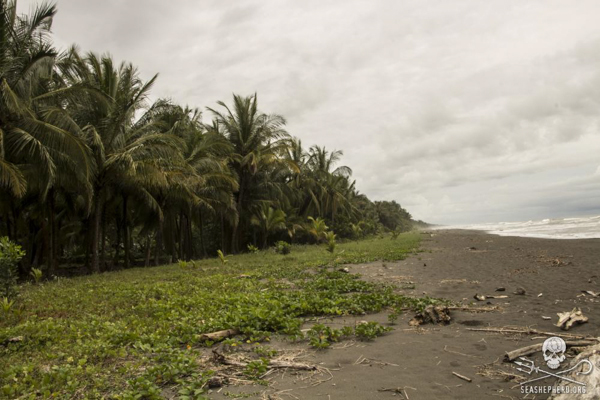 Sea turtle nesting grounds on Pacuare Beach, Costa Rica, where poachers attacked conservationists late last month. Photo credit: Sea Shepherd/Eva Hidalgo. Activists working to protect sea turtles have once again been attacked in Costa Rica. On June 4, volunteers working with the US-based Sea Shepherd Conservation Society interrupted a poacher in the act of stealing […]
Sea turtle nesting grounds on Pacuare Beach, Costa Rica, where poachers attacked conservationists late last month. Photo credit: Sea Shepherd/Eva Hidalgo. Activists working to protect sea turtles have once again been attacked in Costa Rica. On June 4, volunteers working with the US-based Sea Shepherd Conservation Society interrupted a poacher in the act of stealing […]
Can a wild fishery be bred? Indonesia’s plan to restock its oceans
 Abdul “Bolong” Hanan had a baby turtle in one hand and a toothbrush in the other. He scrubbed the squirming two-month-old vigorously before plopping it back into one of the shaded tile pools at his self-designated turtle sanctuary on the southeast end of Gili Meno island off Lombok, Indonesia. Too much algae on a baby […]
Abdul “Bolong” Hanan had a baby turtle in one hand and a toothbrush in the other. He scrubbed the squirming two-month-old vigorously before plopping it back into one of the shaded tile pools at his self-designated turtle sanctuary on the southeast end of Gili Meno island off Lombok, Indonesia. Too much algae on a baby […]
With local help, hawksbill sea turtles make a comeback in Nicaragua
 A hawksbill sea turtle hatchling heads towards the sea. This year over 35,000 hatchlings were born in the Pearl Cays: Photo credit: WCS. Hawksbill sea turtles (Eretmochelys imbricate), a reptile listed as the highest threat level by the IUCN Red List of Endangered Species, are making a momentous local comeback in Nicaragua’s Pearl Cays. This […]
A hawksbill sea turtle hatchling heads towards the sea. This year over 35,000 hatchlings were born in the Pearl Cays: Photo credit: WCS. Hawksbill sea turtles (Eretmochelys imbricate), a reptile listed as the highest threat level by the IUCN Red List of Endangered Species, are making a momentous local comeback in Nicaragua’s Pearl Cays. This […]
Suspects acquitted in shocking murder of sea turtle conservationist
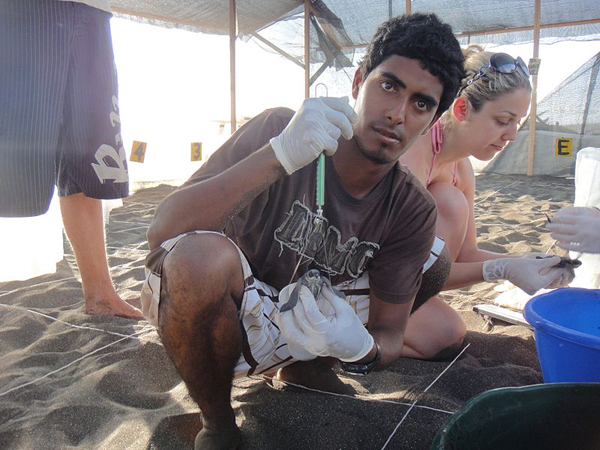 Environmentalist Jairo Mora Sandoval on the beach with fellow WIDECAST volunteers. Photo by: Christine Figgener/Creative Commons 3.0. Yesterday, the seven men accused of brutally murdering Jairo Mora Sandoval on a beach in Costa Rica two years ago were acquitted of the crime. Mora’s murder shocked the Central American country—long known for the progressive protection of […]
Environmentalist Jairo Mora Sandoval on the beach with fellow WIDECAST volunteers. Photo by: Christine Figgener/Creative Commons 3.0. Yesterday, the seven men accused of brutally murdering Jairo Mora Sandoval on a beach in Costa Rica two years ago were acquitted of the crime. Mora’s murder shocked the Central American country—long known for the progressive protection of […]
Nano-tags track baby sea turtles during their first few hours
 Miniature acoustic tags allow researchers to track newborn sea turtles during ‘swimming frenzy’ Baby sea turtles vanish after they scamper into the ocean. Years later, juvenile turtles may pop up thousands of kilometers away, but often scientists don’t see them again until they return to their birthplaces to nest on the beach. Now, using tiny […]
Miniature acoustic tags allow researchers to track newborn sea turtles during ‘swimming frenzy’ Baby sea turtles vanish after they scamper into the ocean. Years later, juvenile turtles may pop up thousands of kilometers away, but often scientists don’t see them again until they return to their birthplaces to nest on the beach. Now, using tiny […]
Saving Peru’s sea turtles and marine birds: conservationists and fishermen partner to tackle bycatch
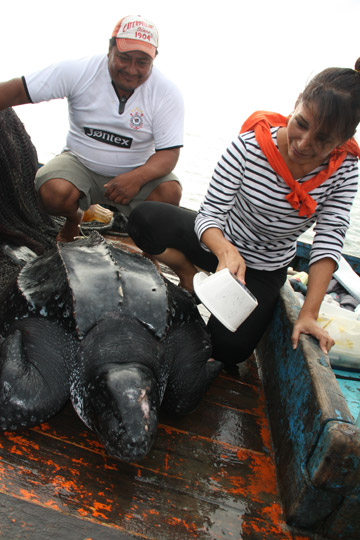 Joanna Alfaro Shigueto will be speaking at the Wildlife Conservation Network Expo in San Francisco on October 11th, 2014. Marine conservationists often view fisheries as an enemy of sorts, vacuuming up fish with little thought to the long-term consequences and using equipment that also ends up killing other species, i.e. bycatch like sea turtles and […]
Joanna Alfaro Shigueto will be speaking at the Wildlife Conservation Network Expo in San Francisco on October 11th, 2014. Marine conservationists often view fisheries as an enemy of sorts, vacuuming up fish with little thought to the long-term consequences and using equipment that also ends up killing other species, i.e. bycatch like sea turtles and […]
No longer ‘deaf as a stump’: researchers find turtles chirp, click, meow, cluck
 Turtles communicate to synchronize hatching, socialize Turtles comprise one of the oldest living groups of reptiles, with hundreds of species found throughout the world. Many have been well-researched, and scientists know very specific things about their various evolutionary histories, metabolic rates, and the ways in which their sexes are determined. But there was one very […]
Turtles communicate to synchronize hatching, socialize Turtles comprise one of the oldest living groups of reptiles, with hundreds of species found throughout the world. Many have been well-researched, and scientists know very specific things about their various evolutionary histories, metabolic rates, and the ways in which their sexes are determined. But there was one very […]
Survey finds huge biological value in Baja California, stalls resort development
 Against an endless blue sky, the blazing sun beat relentlessly onto the sands, throwing off a blinding white glare. Pausing for a moment in the generous shade of a cliff, Benjamin Wilder, Sula Vanderplank, and their team of scientists took in the immense beauty of the landscape unfolding before them. Each set of eyes was […]
Against an endless blue sky, the blazing sun beat relentlessly onto the sands, throwing off a blinding white glare. Pausing for a moment in the generous shade of a cliff, Benjamin Wilder, Sula Vanderplank, and their team of scientists took in the immense beauty of the landscape unfolding before them. Each set of eyes was […]
Chinese poachers caught with 555 marine turtles, most dead (PHOTOS)
 Dead sea turtles confiscated by the Philippine National Police (PNP). Photo by: PNP-SBU/PIA. On Friday, eleven Chinese fishermen were caught by Filipino police with 555 marine turtles, 378 of which were dead. Officials in the Philippines have since released the 177 living turtles. But the incident has sparked an international standoff between the Philippines and […]
Dead sea turtles confiscated by the Philippine National Police (PNP). Photo by: PNP-SBU/PIA. On Friday, eleven Chinese fishermen were caught by Filipino police with 555 marine turtles, 378 of which were dead. Officials in the Philippines have since released the 177 living turtles. But the incident has sparked an international standoff between the Philippines and […]
Malaysia imperils forest reserves and sea turtle nesting ground for industrial site (photos)
 Tanjung Hantu Forest Reserve. Photo by: Nadine Ruppert. Plans for an industrial site threaten one of Malaysia’s only marine turtle nesting beaches and a forest home to rare trees and mammals, according to local activists. Recently, the state government of Perak approved building a liquefied natural gas plant and a steel coil mill inside Tanjung […]
Tanjung Hantu Forest Reserve. Photo by: Nadine Ruppert. Plans for an industrial site threaten one of Malaysia’s only marine turtle nesting beaches and a forest home to rare trees and mammals, according to local activists. Recently, the state government of Perak approved building a liquefied natural gas plant and a steel coil mill inside Tanjung […]
Collateral damage: new findings shed light on the full impact of commercial fishing
 Aside from reducing the populations of the species sought for capture, commercial fisheries are also killing thousands of non-target creatures such as sharks, albatross, and sea turtles, collectively referred to as “bycatch.” However, the full extent of the problem is only beginning to be grasped. In an attempt to fill the many knowledge gaps when […]
Aside from reducing the populations of the species sought for capture, commercial fisheries are also killing thousands of non-target creatures such as sharks, albatross, and sea turtles, collectively referred to as “bycatch.” However, the full extent of the problem is only beginning to be grasped. In an attempt to fill the many knowledge gaps when […]
A Turtle’s Tale: researchers discover baby turtles’ kindergarten (photos)
 Young loggerhead sea turtle with satellite tag released in the Gulf Stream off the coast of southeast Florida. Photo by: Jim Abernethy. Kate Mansfield, at her lab in the University of Central Florida, is holding a baby loggerhead turtle, smaller than her palm, painting manicure acrylic on its shell. When the base coat dries […]
Young loggerhead sea turtle with satellite tag released in the Gulf Stream off the coast of southeast Florida. Photo by: Jim Abernethy. Kate Mansfield, at her lab in the University of Central Florida, is holding a baby loggerhead turtle, smaller than her palm, painting manicure acrylic on its shell. When the base coat dries […]
Top 10 HAPPY environmental stories of 2013
 Also see our Top 10 Environmental Stories of 2013. The discovery of a new tapir species is number seven in our first ever Top 10 List of Happy Environmental Stories. Pictured here is a pair of Kobomani tapirs caught on camera trap. The individual on the left is a female and on the right a […]
Also see our Top 10 Environmental Stories of 2013. The discovery of a new tapir species is number seven in our first ever Top 10 List of Happy Environmental Stories. Pictured here is a pair of Kobomani tapirs caught on camera trap. The individual on the left is a female and on the right a […]
Top 10 Environmental Stories of 2013
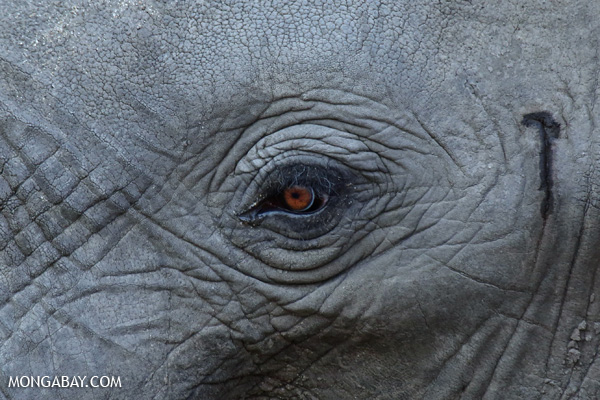 Also see our Top 10 HAPPY environmental stories of 2013. Elephant in South Africa. The poaching crisis in Africa is number six on our annual top ten list. Photo by: Rhett A. Butler. 1. Carbon concentrations hit 400ppm while the IPCC sets global carbon budget: For the first time since our appearance on Earth, carbon […]
Also see our Top 10 HAPPY environmental stories of 2013. Elephant in South Africa. The poaching crisis in Africa is number six on our annual top ten list. Photo by: Rhett A. Butler. 1. Carbon concentrations hit 400ppm while the IPCC sets global carbon budget: For the first time since our appearance on Earth, carbon […]
Over 350 species added to the IUCN Red List’s threatened categories in the last six months
 The number of threatened species on the IUCN Red List has grown by 352 since this summer, according to an update released today. Currently, 21,286 species are now listed as threatened with extinction out of the 71,576 that have been evaluated. The new update comes with both good and bad news for a number of […]
The number of threatened species on the IUCN Red List has grown by 352 since this summer, according to an update released today. Currently, 21,286 species are now listed as threatened with extinction out of the 71,576 that have been evaluated. The new update comes with both good and bad news for a number of […]
Leatherback sea turtle no longer Critically Endangered
 The leatherback sea turtle—the world’s largest turtle and the only member of the genus Dermochelys—received good news today. In an update of the IUCN Red List, the leatherback sea turtle (Dermochelys coriacea) has been moved from Critically Endangered to Vulnerable. However, conservationists warn that the species still remains hugely endangered—and in rapid decline—in many parts […]
The leatherback sea turtle—the world’s largest turtle and the only member of the genus Dermochelys—received good news today. In an update of the IUCN Red List, the leatherback sea turtle (Dermochelys coriacea) has been moved from Critically Endangered to Vulnerable. However, conservationists warn that the species still remains hugely endangered—and in rapid decline—in many parts […]
Longline fisheries in Costa Rica hook tens of thousands of sea turtles every year
 Hundreds of kilometers of commercial fishing lines slither along coastal waters in Costa Rica, hooking thousands of mahi-mahi and many other marketable fish. But when scientists scrutinized fishermen’s catch, they were shocked by the staggering number of sea turtles accidentally snagged on the lines. A study published Aug. 20 in the Journal of Experimental Marine […]
Hundreds of kilometers of commercial fishing lines slither along coastal waters in Costa Rica, hooking thousands of mahi-mahi and many other marketable fish. But when scientists scrutinized fishermen’s catch, they were shocked by the staggering number of sea turtles accidentally snagged on the lines. A study published Aug. 20 in the Journal of Experimental Marine […]
Ultraviolet nets significantly reduce sea turtle bycatch
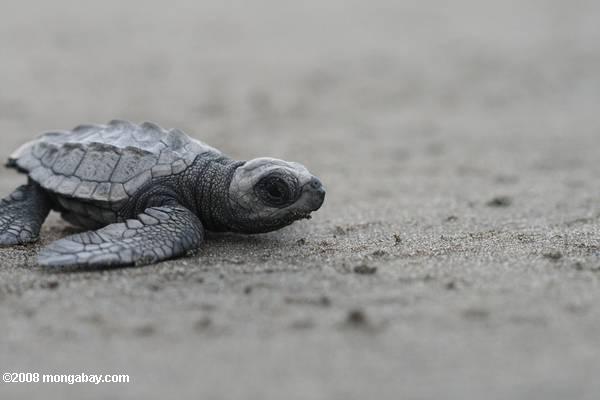 Bycatch, a side-effect of commercial fishing in which non-target species are accidentally caught, is linked to severe population declines in several species. Sea turtles are particularly impacted by small-scale coastal gillnetting practices, in which large nets are deployed and indiscriminately snag anything of a certain size that attempts to swim through them. However, that may […]
Bycatch, a side-effect of commercial fishing in which non-target species are accidentally caught, is linked to severe population declines in several species. Sea turtles are particularly impacted by small-scale coastal gillnetting practices, in which large nets are deployed and indiscriminately snag anything of a certain size that attempts to swim through them. However, that may […]
California celebrates its inaugural Pacific Leatherback Conservation Day with sobering reality
 On an isolated beach in Bird’s Head Peninsula, Indonesia, a female leatherback turtle shuffles out of the ocean and onto the shore, ready to lay her eggs. Under the cover of night she excavates a hole in the sand, depositing anywhere from 80 to 100 eggs inside. Using her flippers she flicks sand over the […]
On an isolated beach in Bird’s Head Peninsula, Indonesia, a female leatherback turtle shuffles out of the ocean and onto the shore, ready to lay her eggs. Under the cover of night she excavates a hole in the sand, depositing anywhere from 80 to 100 eggs inside. Using her flippers she flicks sand over the […]
Are sea turtles responsible for lower fish catches in India?
 Fishing communities on Agatti Island in Lakshwadeep, India, blame their reduced fish catch on green turtles; according to them, green turtles chomp their way through the seagrass beds lining the shallow reef waters that are essential for fish to breed. This leads some in the community to clandestinely kill sea turtles and destroy their nests. […]
Fishing communities on Agatti Island in Lakshwadeep, India, blame their reduced fish catch on green turtles; according to them, green turtles chomp their way through the seagrass beds lining the shallow reef waters that are essential for fish to breed. This leads some in the community to clandestinely kill sea turtles and destroy their nests. […]
Eighty sea turtles wash up dead on the coast of Guatemala
 An assortment of marine animals and birds reside along the black volcanic sand beaches of Guatemala’s Pacific coast, but lately both residents and visitors on the southeast beaches of the country have observed a tragic event – the stranding of dead sea turtles. Eighty dead sea turtles have been recorded since the first week of […]
An assortment of marine animals and birds reside along the black volcanic sand beaches of Guatemala’s Pacific coast, but lately both residents and visitors on the southeast beaches of the country have observed a tragic event – the stranding of dead sea turtles. Eighty dead sea turtles have been recorded since the first week of […]
Suspects arrested in Costa Rican sea turtle conservationist’s murder
 Eight suspects were arrested during early-morning raids Wednesday in the murder of Costa Rican sea turtle conservationist Jairo Mora, reports the TicoTimes.net. The arrests came two months to the day of Mora’s slaying, which occurred on Moín Beach on the Caribbean coast of Costa Rica, while the conservationist and a group of volunteers were patrolling […]
Eight suspects were arrested during early-morning raids Wednesday in the murder of Costa Rican sea turtle conservationist Jairo Mora, reports the TicoTimes.net. The arrests came two months to the day of Mora’s slaying, which occurred on Moín Beach on the Caribbean coast of Costa Rica, while the conservationist and a group of volunteers were patrolling […]
Sea Shepherd to name new ship after slain sea turtle activist
 Marine conservation group Sea Shepherd will name its newest vessel after Jairo Mora Sandoval, a sea turtle conservationist who was slain on a Costa Rican beach last month. “We do not want the name of this courageous and passionate young man to be forgotten and hopefully this will help to keep his memory alive,” said […]
Marine conservation group Sea Shepherd will name its newest vessel after Jairo Mora Sandoval, a sea turtle conservationist who was slain on a Costa Rican beach last month. “We do not want the name of this courageous and passionate young man to be forgotten and hopefully this will help to keep his memory alive,” said […]
Reward for information on sea turtle conservationist’s murder reaches $56,000
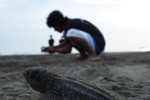 Conservation organizations and individuals have raised $56,000 for information leading to the arrest and conviction of turtle egg poachers who murdered Jairo Mora Sandoval, a 26-year-old sea turtle conservationist earlier this month. Contributions from ten organizations boosted the reward more than five-fold over the past week. Groups have also established a memorial fund for Sandoval. […]
Conservation organizations and individuals have raised $56,000 for information leading to the arrest and conviction of turtle egg poachers who murdered Jairo Mora Sandoval, a 26-year-old sea turtle conservationist earlier this month. Contributions from ten organizations boosted the reward more than five-fold over the past week. Groups have also established a memorial fund for Sandoval. […]
Costa Rican environmentalist pays ultimate price for his dedication to sea turtles
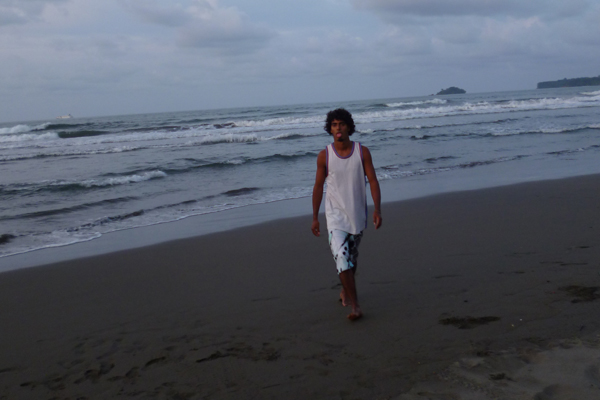 Jairo Mora Sandoval walking on the beach where he died after releasing over a hundred turtle hatchlings in 2012. Photo by: Carlyn Samuel. On the evening of May 30th, 26-year-old Jairo Mora Sandoval was murdered on Moin beach near Limón, Costa Rica, the very stretch of sand where he courageously monitored sea turtle nests for […]
Jairo Mora Sandoval walking on the beach where he died after releasing over a hundred turtle hatchlings in 2012. Photo by: Carlyn Samuel. On the evening of May 30th, 26-year-old Jairo Mora Sandoval was murdered on Moin beach near Limón, Costa Rica, the very stretch of sand where he courageously monitored sea turtle nests for […]
Featured video: saving sea turtles in Mexico’s Magdalena Bay
A new short film, Viva la tortuga documents the struggle to save loggerhead and green sea turtles in Magdalena Bay, Mexico. Once a region for a massive sea turtle meat market, the turtles now face a new threat: bycatch. Loggerhead sea turtles are drowning in bottom-set gillnets, unable to escape from the nets once entangled. […]
Leatherback sea turtles suffer 78 percent decline at critical nesting sites in Pacific
 Leatherback sea turtle laying eggs on the coast of Suriname. Photo by: Tiffany Roufs. The world’s largest sea turtle, the leatherback (Dermochelys coriacea), is vanishing from its most important nesting sites in the western Pacific, according to a new study in Ecosphere. Scientists found that leatherback turtle nests have dropped by 78 percent in less […]
Leatherback sea turtle laying eggs on the coast of Suriname. Photo by: Tiffany Roufs. The world’s largest sea turtle, the leatherback (Dermochelys coriacea), is vanishing from its most important nesting sites in the western Pacific, according to a new study in Ecosphere. Scientists found that leatherback turtle nests have dropped by 78 percent in less […]
Telling the story of the father of sea turtle conservation
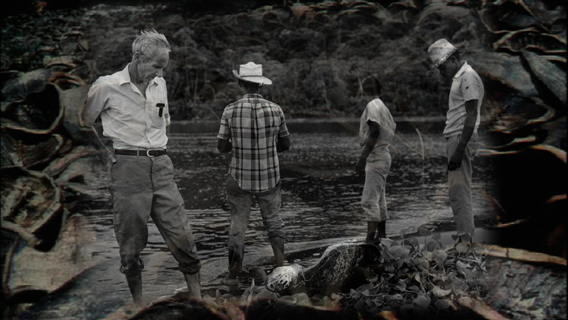 The 3rd Annual New York Wildlife Conservation Film Festival (WFCC.org) runs from January 30 – February 2, 2013. Ahead of the event, Mongabay.com is running a series of Q&As with filmmakers and presenters. For more interviews, please see our WCFF feed. Archer Carr (far left) surveys a turtle killed for its meat. Photo courtesy of […]
The 3rd Annual New York Wildlife Conservation Film Festival (WFCC.org) runs from January 30 – February 2, 2013. Ahead of the event, Mongabay.com is running a series of Q&As with filmmakers and presenters. For more interviews, please see our WCFF feed. Archer Carr (far left) surveys a turtle killed for its meat. Photo courtesy of […]
Climate change threatens population of Earth’s largest sea turtle
 A female leatherback surveys the ocean at Playa Grande, Costa Rica. While her hatchlings will be affected by rising beach temperatures, she faces threats at sea. Photo by: The Leatherback Trust. A drier, hotter climate in Central America could wipe out the population of leatherback sea turtles from the eastern Pacific Ocean by the year […]
A female leatherback surveys the ocean at Playa Grande, Costa Rica. While her hatchlings will be affected by rising beach temperatures, she faces threats at sea. Photo by: The Leatherback Trust. A drier, hotter climate in Central America could wipe out the population of leatherback sea turtles from the eastern Pacific Ocean by the year […]
Pictures of the day: sea turtle and whale shark release in China
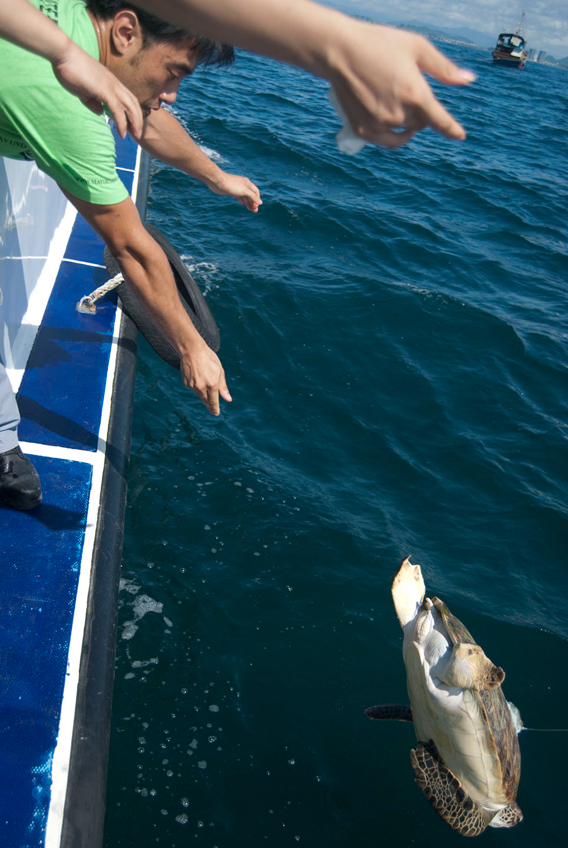 Green sea turtle released back into its natural habitat after being raised for 10 months. Photo by: Sea Turtles 911. Earlier this month, Sea Turtles 911, a conservation organization in China, released two green sea turtles (Chelonia mydas) and a juvenile whale shark (Rhincodon typus) back into the wild. “These two animals share the ocean, […]
Green sea turtle released back into its natural habitat after being raised for 10 months. Photo by: Sea Turtles 911. Earlier this month, Sea Turtles 911, a conservation organization in China, released two green sea turtles (Chelonia mydas) and a juvenile whale shark (Rhincodon typus) back into the wild. “These two animals share the ocean, […]
Jaguar v. sea turtle: when land and marine conservation icons collide
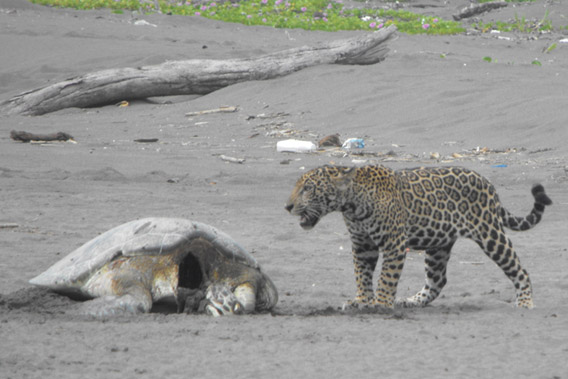 Jaguar with its marine turtle prey. Photo by: Benjamin Barca. At first, an encounter between a jaguar (Panthera onca) and a green sea turtle (Chelonia mydas) seems improbable, even ridiculous, but the two species do come into fatal contact when a female turtle, every two to four years, crawls up a jungle beach to lay […]
Jaguar with its marine turtle prey. Photo by: Benjamin Barca. At first, an encounter between a jaguar (Panthera onca) and a green sea turtle (Chelonia mydas) seems improbable, even ridiculous, but the two species do come into fatal contact when a female turtle, every two to four years, crawls up a jungle beach to lay […]
Educating the next generation of conservation leaders in Colombia
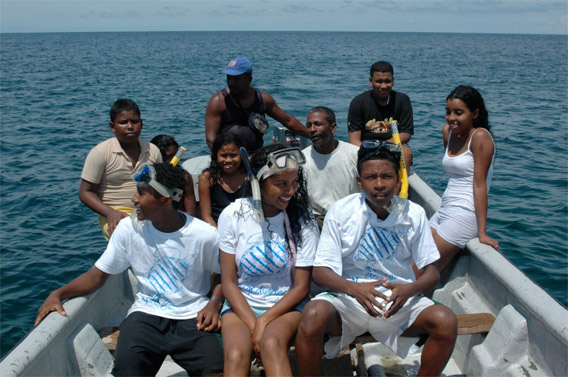 Guardians of Nature students take a field trip to snorkel in coral reefs. Photo courtesy of: Miguel Hernandez. Colombia’s northern departments of Cordoba and Bolivar are home to an abundance of coral reefs, estuaries, mangroves forests, and forests. Rich in both marine and terrestrial wildlife, local communities depend on the sea and land for survival, […]
Guardians of Nature students take a field trip to snorkel in coral reefs. Photo courtesy of: Miguel Hernandez. Colombia’s northern departments of Cordoba and Bolivar are home to an abundance of coral reefs, estuaries, mangroves forests, and forests. Rich in both marine and terrestrial wildlife, local communities depend on the sea and land for survival, […]
Animal photos of the day: green sea turtle saved in China
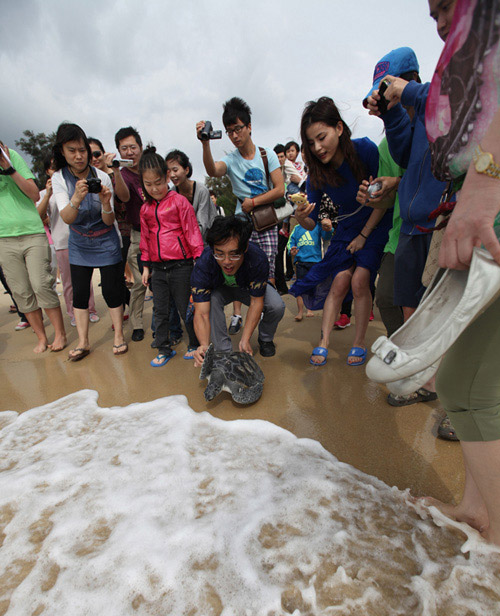 Releasing a green marine turtle named Crush back to the South China Sea. Photo by: Sea Turtles 911. Last month, an organization devoted to marine turtles in the China, Sea Turtles 911, released a green sea turtle (Chelonia mydas) back into the wild in an event that included adoring crowds and a lecture on sea […]
Releasing a green marine turtle named Crush back to the South China Sea. Photo by: Sea Turtles 911. Last month, an organization devoted to marine turtles in the China, Sea Turtles 911, released a green sea turtle (Chelonia mydas) back into the wild in an event that included adoring crowds and a lecture on sea […]
Leatherback sea turtles granted massive protected area along U.S. west coast
 Leatherback sea turtle camouflaging nest in Suriname. Photo by: Tiffany Roufs. The U.S. federal government has designated 108,556 square kilometers (41,914 square miles) as critical habitat for the leatherback sea turtle (Dermochelys coriacea), the largest of the world’s marine turtles and one of the most endangered. The protected area, around the size of Guatemala, spans […]
Leatherback sea turtle camouflaging nest in Suriname. Photo by: Tiffany Roufs. The U.S. federal government has designated 108,556 square kilometers (41,914 square miles) as critical habitat for the leatherback sea turtle (Dermochelys coriacea), the largest of the world’s marine turtles and one of the most endangered. The protected area, around the size of Guatemala, spans […]
Featured video: tuna industry bycatch includes sea turtles, dolphins, whales
WARNING: video is graphic. A Greenpeace video, using footage from a whistleblower, shows disturbing images of the tuna industry operating in the unregulated waters of the Pacific Ocean. Using fish aggregation devices (FADs) and purse seine nets, the industry is not only able to catch entire schools of tuna, including juvenile, but whatever else is […]
Sea turtle deaths in U.S. waters reduced 90%, but shrimp trawling accounts for 98% of kill
 Baby olive ridley sea turtle. Photo by Rhett Butler The number of sea turtles accidentally caught and killed in United States coastal waters has declined by an estimated 90 percent since 1990, reports a new study published in the journal Biological Conservation. The authors, including researchers at Duke University and Duke University, say regulations to […]
Baby olive ridley sea turtle. Photo by Rhett Butler The number of sea turtles accidentally caught and killed in United States coastal waters has declined by an estimated 90 percent since 1990, reports a new study published in the journal Biological Conservation. The authors, including researchers at Duke University and Duke University, say regulations to […]
Leatherback sea turtles tracked for first time in South Atlantic
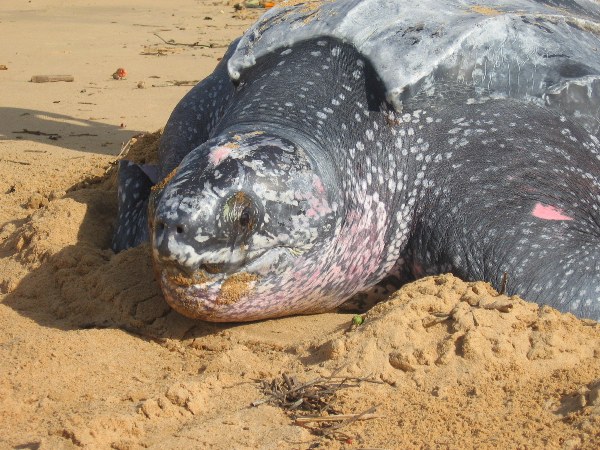 Leatherback sea turtles undertake one of the longest journeys of any animal as they traverse the oceans in search of food, navigating hazards such as plastic pollution and fishing operations. A new study published in the Royal Society Journal Proceedings B has for the first time mapped their odyssey through the South Atlantic. Leatherbacks are […]
Leatherback sea turtles undertake one of the longest journeys of any animal as they traverse the oceans in search of food, navigating hazards such as plastic pollution and fishing operations. A new study published in the Royal Society Journal Proceedings B has for the first time mapped their odyssey through the South Atlantic. Leatherbacks are […]
‘Environmental and social aggression’: oil exploration threatens award-winning marine protected area
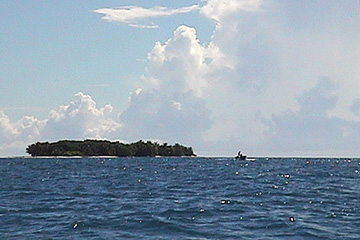 Oil plans put wildlife, people, and award-winning sustainability efforts in the Colombian Caribbean at risk. The Seaflower Marine Protected Area (MPA), which recently won top honors at the Convention on Biological Diversity (CBD) in Japan, is now under threat by planned oil exploration in the region, according to the Providence Foundation which is devoted to […]
Oil plans put wildlife, people, and award-winning sustainability efforts in the Colombian Caribbean at risk. The Seaflower Marine Protected Area (MPA), which recently won top honors at the Convention on Biological Diversity (CBD) in Japan, is now under threat by planned oil exploration in the region, according to the Providence Foundation which is devoted to […]
Massive shark sanctuary declared in the Coral Triangle
A shark sanctuary has been declared around the Raja Ampat islands in Indonesia. Larger than Denmark, the new sanctuary covers 17,760 square miles (46,000 square kilometers) of one of the world’s richest marine biodiverse region, the Coral Triangle. Protections not only cover sharks, but dugongs, marine turtles, mobulas, and manta rays as well. In addition, […]
Thousands of marine turtles slaughtered in Madagascar for food
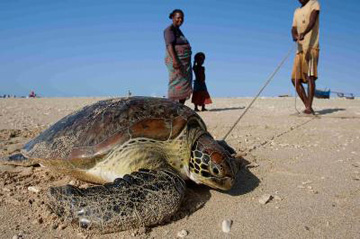 Over 10,000 marine turtles are being killed in one region of Madagascar for food every year, according to a new study in Animal Conservation. Although fishing for marine turtles is illegal, it has not stopped local artisanal fishermen from pursuing four different endangered marine turtle species. “We conducted this study because we know this small-scale, […]
Over 10,000 marine turtles are being killed in one region of Madagascar for food every year, according to a new study in Animal Conservation. Although fishing for marine turtles is illegal, it has not stopped local artisanal fishermen from pursuing four different endangered marine turtle species. “We conducted this study because we know this small-scale, […]
Photos: ants take top prize at Veolia Wildlife Environment Photography contest
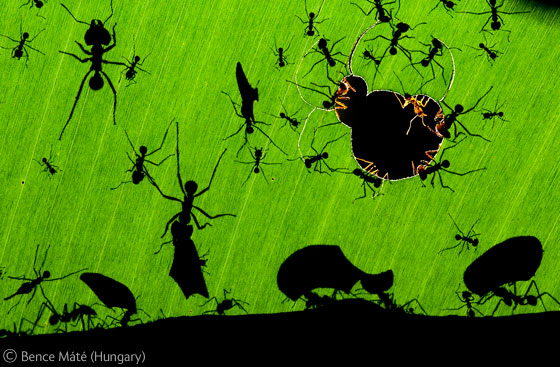 An image of nocturnal ant silhouettes systematically devouring a leaf in Costa Rica has given Hungarian photographer, Bence Máté, the much-coveted Veolia Wildlife Environment Photographer of the Year award. In addition to being named Photographer of the year, Máté also won the Erik Hosking award, given to a young photographer (ages 18-26) for a portfolio […]
An image of nocturnal ant silhouettes systematically devouring a leaf in Costa Rica has given Hungarian photographer, Bence Máté, the much-coveted Veolia Wildlife Environment Photographer of the Year award. In addition to being named Photographer of the year, Máté also won the Erik Hosking award, given to a young photographer (ages 18-26) for a portfolio […]
Will we ever know the full wildlife toll of the BP oil spill?
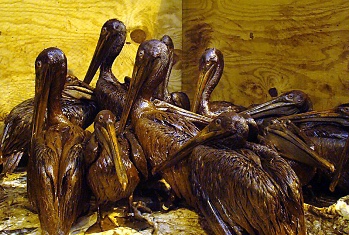 Will we ever know the full wildlife toll of the BP oil spill? The short answer: no. The gruesome photos that are making the media rounds over the last week of oiled birds, fish, and crustaceans are according to experts only a small symbol of the ecological catastrophe that is likely occurring both in shallow […]
Will we ever know the full wildlife toll of the BP oil spill? The short answer: no. The gruesome photos that are making the media rounds over the last week of oiled birds, fish, and crustaceans are according to experts only a small symbol of the ecological catastrophe that is likely occurring both in shallow […]
Mexico has big role in the illegal parrot trade
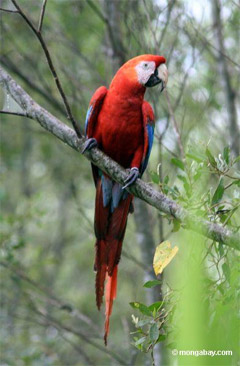 Juan Carlos Cantu, Director of Defenders of Wildlife’s Mexico office, spoke with Laurel Neme on her “The WildLife” radio show and podcast about the illegal parrot trade in Mexico and how his innovative research into the trade was used by the Mexican Congress to reform that country’s Wildlife Law to ban all trade in parrots. […]
Juan Carlos Cantu, Director of Defenders of Wildlife’s Mexico office, spoke with Laurel Neme on her “The WildLife” radio show and podcast about the illegal parrot trade in Mexico and how his innovative research into the trade was used by the Mexican Congress to reform that country’s Wildlife Law to ban all trade in parrots. […]
Wildlife death toll from BP oil spill likely includes dolphins
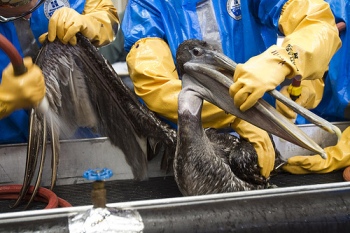 The oil spill in the Gulf of Mexico is taking its toll on the region’s wildlife: brown pelicans, sea turtles, several species of fish, and now dolphins have been found dead. The National Marine Fisheries Service reported today finding six dead dolphins in Louisiana, Mississippi, and Alabama since May 2nd. Officials are saying the deaths […]
The oil spill in the Gulf of Mexico is taking its toll on the region’s wildlife: brown pelicans, sea turtles, several species of fish, and now dolphins have been found dead. The National Marine Fisheries Service reported today finding six dead dolphins in Louisiana, Mississippi, and Alabama since May 2nd. Officials are saying the deaths […]
New report finds millions of marine turtles killed by fisheries, not thousands
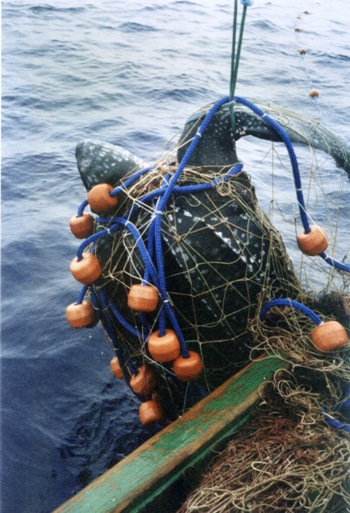 Humankind’s appetite for seafood has had a bigger impact on the world’s marine turtles than long thought. A new report by Conservation International (CI) in partnership with Duke University’s Project GloBAL (Global By-catch Assessment of Long-lived Species) finds that in the past eighteen years it is likely millions of marine turtles have been killed as […]
Humankind’s appetite for seafood has had a bigger impact on the world’s marine turtles than long thought. A new report by Conservation International (CI) in partnership with Duke University’s Project GloBAL (Global By-catch Assessment of Long-lived Species) finds that in the past eighteen years it is likely millions of marine turtles have been killed as […]
Giant guano outcroppings win protection as bird habitat in Peru
 The Peruvian government has moved to protect 33 guano sites—both islands and peninsulas—as well as surrounding waters in a bid to save declining bird populations. Millions of birds nest on these guano sites every year, including endangered species such as the Peruvian Diving-petrel and the Humboldt Penguin. The protections, which were first proposed in 2001, […]
The Peruvian government has moved to protect 33 guano sites—both islands and peninsulas—as well as surrounding waters in a bid to save declining bird populations. Millions of birds nest on these guano sites every year, including endangered species such as the Peruvian Diving-petrel and the Humboldt Penguin. The protections, which were first proposed in 2001, […]
Photos: ten beloved species threatened by global warming
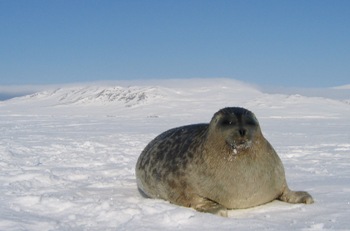 The International Union for the Conservation of Nature (IUCN) has released a list of ten species that are likely to be among the hardest hit by climate change, including beloved species such as the leatherback sea turtle, the koala, the emperor penguin, the clownfish, and the beluga whale. The timing of the list coincides with […]
The International Union for the Conservation of Nature (IUCN) has released a list of ten species that are likely to be among the hardest hit by climate change, including beloved species such as the leatherback sea turtle, the koala, the emperor penguin, the clownfish, and the beluga whale. The timing of the list coincides with […]
Costa Rica proposes to downgrade Las Baulas National Park, threatening leatherback sea turtles
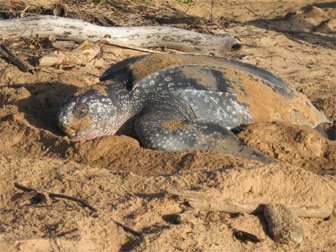 Costa Rica is considered by many to be a shining example of environmental stewardship, preserving both its terrestrial and marine biodiversity while benefiting from being a popular tourist location. However, a new move by the Costa Rican government has placed their reputation in question. In May of this year the President of Costa Rica, Oscar […]
Costa Rica is considered by many to be a shining example of environmental stewardship, preserving both its terrestrial and marine biodiversity while benefiting from being a popular tourist location. However, a new move by the Costa Rican government has placed their reputation in question. In May of this year the President of Costa Rica, Oscar […]
Oil spill off Australia potential ‘disaster’ for marine wildlife
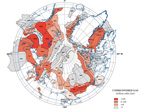
Scientists find world’s largest leatherback sea turtle population in Gabon
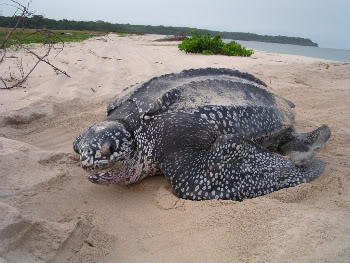 Scientists have found the world’s largest population of nesting leatherback sea turtles. On the beaches of Gabon in West Africa land and air surveys estimated the small country’s leatherback population to be between 15,730 and 41,373 individual females. The findings are published in Biological Conservation. “We knew that Gabon was an important nesting site for […]
Scientists have found the world’s largest population of nesting leatherback sea turtles. On the beaches of Gabon in West Africa land and air surveys estimated the small country’s leatherback population to be between 15,730 and 41,373 individual females. The findings are published in Biological Conservation. “We knew that Gabon was an important nesting site for […]
Plastic garbage accounts for one-third of leatherback sea turtle mortalities
 A new study in Marine Pollution Bulletin has confirmed that the world’s largest sea turtle is succumbing in startling numbers to an environmental issue that receives little attention: plastic trash in the oceans. To conduct his study Dr. Mike James from Dalhousie University and colleagues looked back over four decades of leatherback necropsies, i.e. post-mortems […]
A new study in Marine Pollution Bulletin has confirmed that the world’s largest sea turtle is succumbing in startling numbers to an environmental issue that receives little attention: plastic trash in the oceans. To conduct his study Dr. Mike James from Dalhousie University and colleagues looked back over four decades of leatherback necropsies, i.e. post-mortems […]
Little-known flatback sea turtle receives extra attention at symposium in Australia

Saving leatherback turtles in South America’s smallest country, Suriname: An interview with Liz McHuron
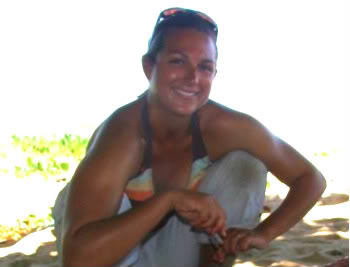
Mosques Support Sea Turtle Conservation in Malaysia
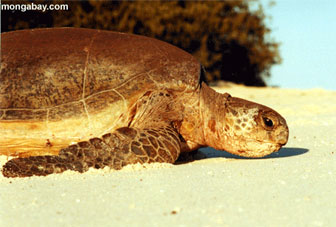 Mosques Support Sea Turtle Conservation in Malaysia Mosques Support Sea Turtle Conservation in Malaysia Nathan Brouwer, special to mongabay.com November 17, 2008
Mosques Support Sea Turtle Conservation in Malaysia Mosques Support Sea Turtle Conservation in Malaysia Nathan Brouwer, special to mongabay.com November 17, 2008
Thousands of endangered sea turtles killed as fishing bycatch in Mexico
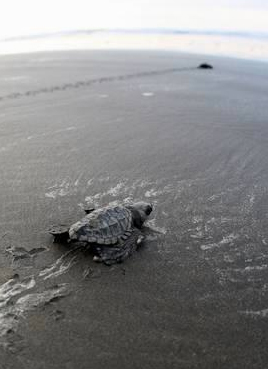 Thousands of endangered sea turtles killed as fishing bycatch in Mexico Thousands of endangered sea turtles killed as fishing bycatch in Mexico mongabay.com October 15, 2008
Thousands of endangered sea turtles killed as fishing bycatch in Mexico Thousands of endangered sea turtles killed as fishing bycatch in Mexico mongabay.com October 15, 2008
The long-ignored ocean emergency and what can be done to address it
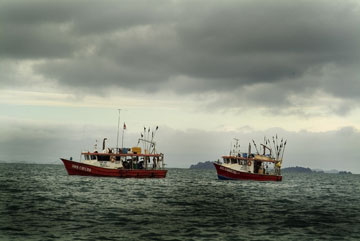 This year has been full of bad news regarding marine ecosystems: one-third of coral species threatened with extinction, dead-zones spread to 415 sites, half of U.S. reefs in fair or bad condition, increase in ocean acidification, tuna and shark populations collapsing, and only four percent of ocean considered pristine. Jeremy Jackson, director of the Scripps […]
This year has been full of bad news regarding marine ecosystems: one-third of coral species threatened with extinction, dead-zones spread to 415 sites, half of U.S. reefs in fair or bad condition, increase in ocean acidification, tuna and shark populations collapsing, and only four percent of ocean considered pristine. Jeremy Jackson, director of the Scripps […]
How sustainable is your canned tuna? It depends on the retailer
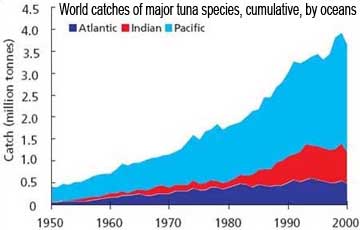 How sustainable is your canned tuna? It depends on the retailer Sainsbury’s has the most sustainable tuna, John West the least Jeremy Hance, mongabay.com August 13, 2008 To aid concerned tuna-lovers, Greenpeace has ranked eight of the top canned tuna retailers in order from most sustainable to least. Canned tuna from John West, the biggest […]
How sustainable is your canned tuna? It depends on the retailer Sainsbury’s has the most sustainable tuna, John West the least Jeremy Hance, mongabay.com August 13, 2008 To aid concerned tuna-lovers, Greenpeace has ranked eight of the top canned tuna retailers in order from most sustainable to least. Canned tuna from John West, the biggest […]
“Turtle carbon” could help protect rainforests and save endangered sea turtles
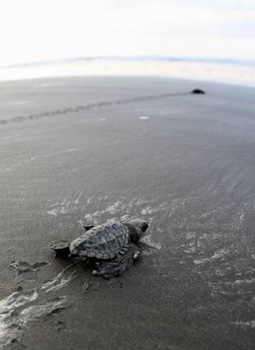 “Turtle carbon” could help protect rainforests and save endangered sea turtles “Turtle carbon” could help protect rainforests and save endangered sea turtles Rhett A. Butler, mongabay.com August 12, 2008 Using carbon credits to promote rainforest conservation could help protect endangered sea turtles in some parts of the world, argues a carbon finance expert. Gabriel Thoumi, […]
“Turtle carbon” could help protect rainforests and save endangered sea turtles “Turtle carbon” could help protect rainforests and save endangered sea turtles Rhett A. Butler, mongabay.com August 12, 2008 Using carbon credits to promote rainforest conservation could help protect endangered sea turtles in some parts of the world, argues a carbon finance expert. Gabriel Thoumi, […]
Madagascar villagers vote to protect sea turtles, see first hatchlings
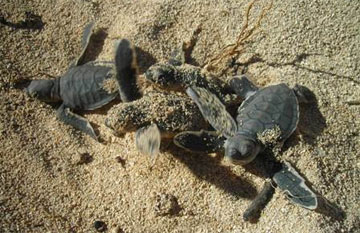 Madagascar villagers vote to protect sea turtles, see first hatchlings Madagascar villagers vote to protect sea turtles, see first hatchlings Blue Ventures July 15, 2008 The first hatching of Green Turtles recorded as a direct result of efforts to protect the species in southwest Madagascar has been witnessed by marine conservationists working for British charity, […]
Madagascar villagers vote to protect sea turtles, see first hatchlings Madagascar villagers vote to protect sea turtles, see first hatchlings Blue Ventures July 15, 2008 The first hatching of Green Turtles recorded as a direct result of efforts to protect the species in southwest Madagascar has been witnessed by marine conservationists working for British charity, […]
Discovery of new leatherback migration route may help save species
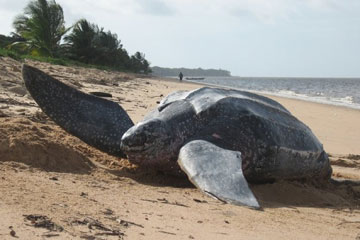 Discovery of new leatherback migration route may help save species Discovery of new leatherback migration route may help save species Jeremy Hance, mongabay.com July 15, 2008 Scientists have discovered a new migration route for the world’s largest turtle, the leatherback. The route takes the 2,000-pound marine turtle from the Playa Grande beaches in Costa Rica […]
Discovery of new leatherback migration route may help save species Discovery of new leatherback migration route may help save species Jeremy Hance, mongabay.com July 15, 2008 Scientists have discovered a new migration route for the world’s largest turtle, the leatherback. The route takes the 2,000-pound marine turtle from the Playa Grande beaches in Costa Rica […]
Volunteering with Leatherback Sea Turtles in Galibi, Suriname
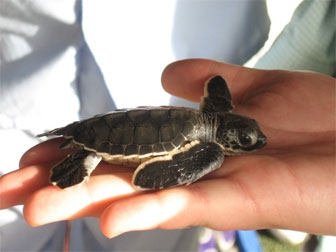 Volunteering with Leatherback Sea Turtles in Galibi, Suriname Volunteering with Leatherback Sea Turtles in Galibi, Suriname Jeremy Hance, mongabay.com July 8, 2008 The northern coast of Suriname is one of the best places in the world to view the largest turtle, the marine Leatherback. Watching the turtle rise out of the tides onto the beach […]
Volunteering with Leatherback Sea Turtles in Galibi, Suriname Volunteering with Leatherback Sea Turtles in Galibi, Suriname Jeremy Hance, mongabay.com July 8, 2008 The northern coast of Suriname is one of the best places in the world to view the largest turtle, the marine Leatherback. Watching the turtle rise out of the tides onto the beach […]
New ‘red list’ seeks to stave off global seafood collapse
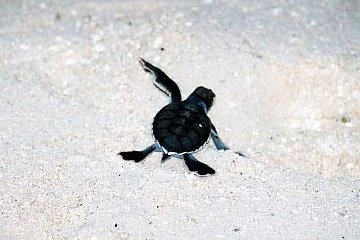 New ‘red list’ seeks to stave off global seafood collapse New ‘red list’ seeks to stave off global seafood collapse Jeremy Hance, mongabay.com March 3, 2008 Over-fishing and destructive fishing practices have had a considerable effect on oceanic ecosystems. In 2006 a highly-reported study found that without drastic measures all wild seafood will disappear from […]
New ‘red list’ seeks to stave off global seafood collapse New ‘red list’ seeks to stave off global seafood collapse Jeremy Hance, mongabay.com March 3, 2008 Over-fishing and destructive fishing practices have had a considerable effect on oceanic ecosystems. In 2006 a highly-reported study found that without drastic measures all wild seafood will disappear from […]
Rainforest logging threatens endangered sea turtles
 Rainforest logging threatens endangered sea turtles Rainforest logging threatens endangered sea turtles Rhett A. Butler, mongabay.com February 25, 2008 Logging is having an unexpected impact on endangered sea turtles in Central Africa, reports a new study published in Oryx. Aerial surveys in Gabon reveal that logs lost during transport are clogging beaches, preventing critically endangered […]
Rainforest logging threatens endangered sea turtles Rainforest logging threatens endangered sea turtles Rhett A. Butler, mongabay.com February 25, 2008 Logging is having an unexpected impact on endangered sea turtles in Central Africa, reports a new study published in Oryx. Aerial surveys in Gabon reveal that logs lost during transport are clogging beaches, preventing critically endangered […]
Sea turtle makes record migration – 12,774 miles
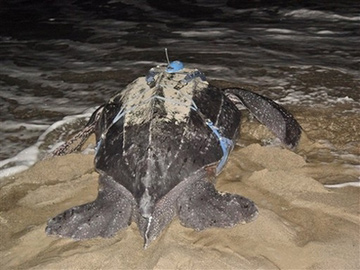 Satellite-tagging has revealed that a leatherback sea turtle (Dermochelys coriacea) swam a total distance of 20,558 kilometers (12,774 miles) over 647 days from Jamursba-Medi, Indonesia to the coast of Oregon. The results are published in The State of the World’s Sea Turtles magazine, a publication launched by Conservation International and the IUCN Marine Turtle Specialist […]
Satellite-tagging has revealed that a leatherback sea turtle (Dermochelys coriacea) swam a total distance of 20,558 kilometers (12,774 miles) over 647 days from Jamursba-Medi, Indonesia to the coast of Oregon. The results are published in The State of the World’s Sea Turtles magazine, a publication launched by Conservation International and the IUCN Marine Turtle Specialist […]
Study shows that sea turtles can recover
 Study shows that sea turtles can recover Study shows that sea turtles can recover mongabay.com December 18, 2007 Conservation of sea turtle nesting sites is paying off for the endangered reptiles, reports a new study published this week in the journal Global Ecology and Biogeography. A team of researchers led researchers from IUCN and Conservation […]
Study shows that sea turtles can recover Study shows that sea turtles can recover mongabay.com December 18, 2007 Conservation of sea turtle nesting sites is paying off for the endangered reptiles, reports a new study published this week in the journal Global Ecology and Biogeography. A team of researchers led researchers from IUCN and Conservation […]
86% of sea turtle species threatened with extinction
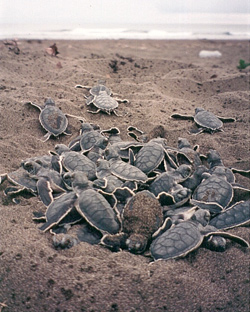 86% of sea turtle species threatened with extinction 86% of sea turtle species threatened with extinction Turtle conservation is like its namesake: it’s slow, but there are big rewards Ken Burton of the U.S. Fish and Wildlife Service Special to mongabay.com November 14, 2007 Marine turtles have thrived for more than 100 million years. But […]
86% of sea turtle species threatened with extinction 86% of sea turtle species threatened with extinction Turtle conservation is like its namesake: it’s slow, but there are big rewards Ken Burton of the U.S. Fish and Wildlife Service Special to mongabay.com November 14, 2007 Marine turtles have thrived for more than 100 million years. But […]
Mexican fishing villages work to change practices to preserve loggerhead turtles
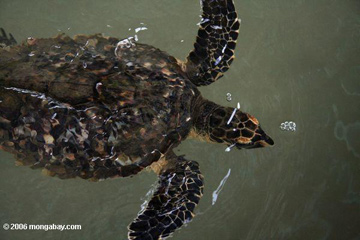 Mexican fishing villages work to change practices to preserve loggerhead turtles Mexican fishing villages work to change practices to preserve loggerhead turtles University of California – Santa Cruz October 16, 2007 Small-scale fishing in Mexico rivals industrial fisheries in accidental turtle deaths SANTA CRUZ, CA–Industrial fishing operations take plenty of blame for both depleting fish […]
Mexican fishing villages work to change practices to preserve loggerhead turtles Mexican fishing villages work to change practices to preserve loggerhead turtles University of California – Santa Cruz October 16, 2007 Small-scale fishing in Mexico rivals industrial fisheries in accidental turtle deaths SANTA CRUZ, CA–Industrial fishing operations take plenty of blame for both depleting fish […]
Stephen Colbert’s sea turtle second in race to Galapagos
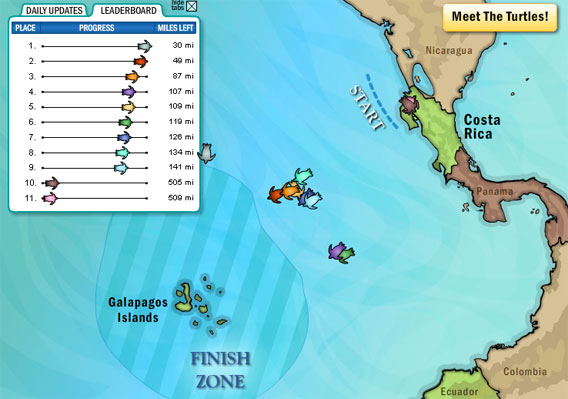 Stephen Colbert’s sea turtle second in race to Galapagos Stephen Colbert’s sea turtle second in race to Galapagos mongabay.com April 25, 2007 Nearing the end of Great Turtle Race, Stephen Colbert’s sea turtle “Stephanie Colburtle” was in second place, 18 miles behind “Billie”, a turtle sponsored by Offield Center for Billfish Studies. Billie is just […]
Stephen Colbert’s sea turtle second in race to Galapagos Stephen Colbert’s sea turtle second in race to Galapagos mongabay.com April 25, 2007 Nearing the end of Great Turtle Race, Stephen Colbert’s sea turtle “Stephanie Colburtle” was in second place, 18 miles behind “Billie”, a turtle sponsored by Offield Center for Billfish Studies. Billie is just […]
Stephen Colbert’s sea turtle currently third in race
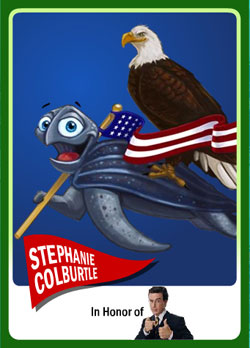 Stephen Colbert’s sea turtle currently third in race Stephen Colbert’s sea turtle currently third in race CI April 19, 2007 On the fourth day of the Great Turtle Race, 3 of the leatherback turtles have completed Stage One, passing the 200-mile marker of the 500-mile race from Costa Rica to the Galapagos. The Great Turtle […]
Stephen Colbert’s sea turtle currently third in race Stephen Colbert’s sea turtle currently third in race CI April 19, 2007 On the fourth day of the Great Turtle Race, 3 of the leatherback turtles have completed Stage One, passing the 200-mile marker of the 500-mile race from Costa Rica to the Galapagos. The Great Turtle […]
Racing sea turtle named in honor of Stephen Colbert
 Racing sea turtle named in honor of Stephen Colbert Racing sea turtle named in honor of Stephen Colbert Conservation International April 13, 2007 An eleventh turtle named Stephanie Colburtle has joined competitors Yahoo!, Travelocity, Plantronics, West Marine, Dreyer’s Ice Cream and other sponsors in The Great Turtle Race, a unique international sea turtle conservation event […]
Racing sea turtle named in honor of Stephen Colbert Racing sea turtle named in honor of Stephen Colbert Conservation International April 13, 2007 An eleventh turtle named Stephanie Colburtle has joined competitors Yahoo!, Travelocity, Plantronics, West Marine, Dreyer’s Ice Cream and other sponsors in The Great Turtle Race, a unique international sea turtle conservation event […]
Great Turtle Race set to launch from Costa Rica
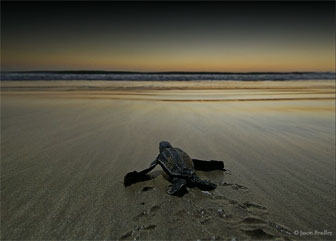 Great Turtle Race set to launch from Costa Rica Great Turtle Race set to launch from Costa Rica Modified release from Conservation International April 4, 2007 The Great Turtle Race, a unique international sea turtle conservation event bringing corporate sponsors together with conservation organizations, will take place from April 16 to April 29 in a […]
Great Turtle Race set to launch from Costa Rica Great Turtle Race set to launch from Costa Rica Modified release from Conservation International April 4, 2007 The Great Turtle Race, a unique international sea turtle conservation event bringing corporate sponsors together with conservation organizations, will take place from April 16 to April 29 in a […]
Sea turtles use Earth’s magnetic field to return to nesting beaches
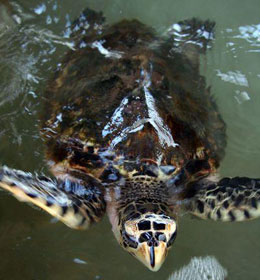 Sea turtles use Earth’s magnetic field to return to nesting beaches Sea turtles use Earth’s magnetic field to return to nesting beaches mongabay.com February 27, 2007 New research suggests that sea turtles use a “relatively simple navigation system” involving the Earth’s magnetic field to return to the same beaches to lay their eggs, even after […]
Sea turtles use Earth’s magnetic field to return to nesting beaches Sea turtles use Earth’s magnetic field to return to nesting beaches mongabay.com February 27, 2007 New research suggests that sea turtles use a “relatively simple navigation system” involving the Earth’s magnetic field to return to the same beaches to lay their eggs, even after […]
Protecting sea turtles in Costa Rica
 Protecting sea turtles in Costa Rica Protecting sea turtles in Costa Rica Noël Dunn September 27, 2006 Travel account: monitoring sea turtle nesting sites on the beaches of Costa Rica I thought I was moving to Costa Rica but instead I’ve found myself well inside the discovery channel. I live in Puerto Vargas–not a town […]
Protecting sea turtles in Costa Rica Protecting sea turtles in Costa Rica Noël Dunn September 27, 2006 Travel account: monitoring sea turtle nesting sites on the beaches of Costa Rica I thought I was moving to Costa Rica but instead I’ve found myself well inside the discovery channel. I live in Puerto Vargas–not a town […]
Historic Caribbean sea turtle population falls 99%
 Historic Caribbean sea turtle population falls 99% Historic Caribbean sea turtle population falls 99% Plunge has significant ecological consequences mongabay.com August 1, 2006 Current conservation assessments of endangered Caribbean sea turtles are too optimistic due declines of populations on historically important nesting beaches, according to new research from the Scripps Institution of Oceanography. The study, […]
Historic Caribbean sea turtle population falls 99% Historic Caribbean sea turtle population falls 99% Plunge has significant ecological consequences mongabay.com August 1, 2006 Current conservation assessments of endangered Caribbean sea turtles are too optimistic due declines of populations on historically important nesting beaches, according to new research from the Scripps Institution of Oceanography. The study, […]
Red Tide Causes Sea Turtle Die-Off in El Salvador
 Red Tide Causes Sea Turtle Die-Off in El Salvador Red Tide Causes Sea Turtle Die-Off in El Salvador Wildlife Conservation Society March 23, 2006 A “Red Tide” event that occurred off the coast of El Salvador late last year directly caused the deaths of some 200 sea turtles, according to test results released today by […]
Red Tide Causes Sea Turtle Die-Off in El Salvador Red Tide Causes Sea Turtle Die-Off in El Salvador Wildlife Conservation Society March 23, 2006 A “Red Tide” event that occurred off the coast of El Salvador late last year directly caused the deaths of some 200 sea turtles, according to test results released today by […]
Sea turtle first animal returned to New Orleans Aquarium after hurricane
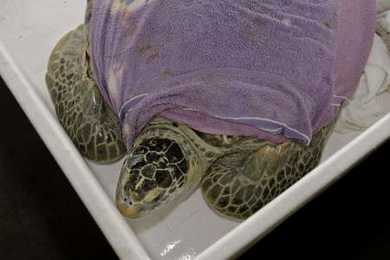 Sea turtle first animal returned to New Orleans Aquarium after hurricane Sea turtle first animal returned to New Orleans Aquarium after hurricane mongabay.com October 13, 2005 “King Midas,” a 136 kg (300lb) green sea turtle, sits in a plastic bin with a wet towel over his shell as he is returned to his tank at […]
Sea turtle first animal returned to New Orleans Aquarium after hurricane Sea turtle first animal returned to New Orleans Aquarium after hurricane mongabay.com October 13, 2005 “King Midas,” a 136 kg (300lb) green sea turtle, sits in a plastic bin with a wet towel over his shell as he is returned to his tank at […]
Sea turtles temporarily lose protection in wake of Hurricane Katrina
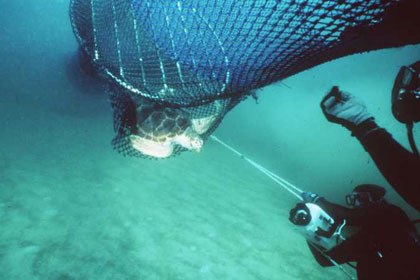 Sea turtles temporarily lose protection from trawlers in wake of Hurricane Katrina Sea turtles temporarily lose protection from trawlers in wake of Hurricane Katrina Release from the Louisiana Department of Wildlife and Fisheries October 2, 2005 The National Marine Fisheries Service (NMFS) has granted shrimp trawlers a temporary 30-day exemption from federal Turtle Excluder Device […]
Sea turtles temporarily lose protection from trawlers in wake of Hurricane Katrina Sea turtles temporarily lose protection from trawlers in wake of Hurricane Katrina Release from the Louisiana Department of Wildlife and Fisheries October 2, 2005 The National Marine Fisheries Service (NMFS) has granted shrimp trawlers a temporary 30-day exemption from federal Turtle Excluder Device […]
Sex sells sea turtle conservation in Mexico
 Sex sells sea turtle conservation in Mexico Sex sells sea turtle conservation in Mexico Rhett A. Butler, mongabay.com August 19, 2005 Updated September 6, 2005 Mexican authorities announced they will use posters of scantily dressed young women to promote the protection of endangered sea turtles. The promotion comes just weeks after some 80 protected Olive […]
Sex sells sea turtle conservation in Mexico Sex sells sea turtle conservation in Mexico Rhett A. Butler, mongabay.com August 19, 2005 Updated September 6, 2005 Mexican authorities announced they will use posters of scantily dressed young women to promote the protection of endangered sea turtles. The promotion comes just weeks after some 80 protected Olive […]
Sea turtle massacre in Mexico
 Sea turtle massacre in Mexico Sea turtle massacre in Mexico Rhett A. Butler, mongabay.com August 11, 2005 Using machetes, poachers killed some 80 protected Olive Ridley sea turtles on Escobilla beach in Oaxaca, Mexico last weekend. The poachers were believed to be after turtle eggs, thought to be an aphrodisiac among locals. The discovery of […]
Sea turtle massacre in Mexico Sea turtle massacre in Mexico Rhett A. Butler, mongabay.com August 11, 2005 Using machetes, poachers killed some 80 protected Olive Ridley sea turtles on Escobilla beach in Oaxaca, Mexico last weekend. The poachers were believed to be after turtle eggs, thought to be an aphrodisiac among locals. The discovery of […]
Feeds: news | india | latam | brasil | indonesia
 The most popular stories from our Spanish-language service, Mongabay-Latam, last week followed what is causing an 80 percent decline in some sea turtle populations in Peru, mafias and deforestation in Colombia, and fracking in Bolivia. Banner image: The hook in the photo above can cause internal damage that is fatal for sea turtles. Image courtesy of […]
The most popular stories from our Spanish-language service, Mongabay-Latam, last week followed what is causing an 80 percent decline in some sea turtle populations in Peru, mafias and deforestation in Colombia, and fracking in Bolivia. Banner image: The hook in the photo above can cause internal damage that is fatal for sea turtles. Image courtesy of […] These were the most read stories published by our Spanish-language service, Mongabay-Latam, last week: Scientists in Colombia strive to understand what is happening with the Athelopus frog genus in order to save them from extinction, while a cattle ranch in Bolivia opts for an ambitious sustainable tourism project, and more. Keep up to date with […]
These were the most read stories published by our Spanish-language service, Mongabay-Latam, last week: Scientists in Colombia strive to understand what is happening with the Athelopus frog genus in order to save them from extinction, while a cattle ranch in Bolivia opts for an ambitious sustainable tourism project, and more. Keep up to date with […] There is a longstanding disagreement amongst conservationists about whether or not it makes sense to focus efforts on protecting species that are popular with us Homo sapiens. Many argue that conserving the most imperiled species should be the priority, or that a species’ importance to the ecosystem in which it lives should be the decisive […]
There is a longstanding disagreement amongst conservationists about whether or not it makes sense to focus efforts on protecting species that are popular with us Homo sapiens. Many argue that conserving the most imperiled species should be the priority, or that a species’ importance to the ecosystem in which it lives should be the decisive […] Sea turtle nesting grounds on Pacuare Beach, Costa Rica, where poachers attacked conservationists late last month. Photo credit: Sea Shepherd/Eva Hidalgo. Activists working to protect sea turtles have once again been attacked in Costa Rica. On June 4, volunteers working with the US-based Sea Shepherd Conservation Society interrupted a poacher in the act of stealing […]
Sea turtle nesting grounds on Pacuare Beach, Costa Rica, where poachers attacked conservationists late last month. Photo credit: Sea Shepherd/Eva Hidalgo. Activists working to protect sea turtles have once again been attacked in Costa Rica. On June 4, volunteers working with the US-based Sea Shepherd Conservation Society interrupted a poacher in the act of stealing […] Abdul “Bolong” Hanan had a baby turtle in one hand and a toothbrush in the other. He scrubbed the squirming two-month-old vigorously before plopping it back into one of the shaded tile pools at his self-designated turtle sanctuary on the southeast end of Gili Meno island off Lombok, Indonesia. Too much algae on a baby […]
Abdul “Bolong” Hanan had a baby turtle in one hand and a toothbrush in the other. He scrubbed the squirming two-month-old vigorously before plopping it back into one of the shaded tile pools at his self-designated turtle sanctuary on the southeast end of Gili Meno island off Lombok, Indonesia. Too much algae on a baby […] A hawksbill sea turtle hatchling heads towards the sea. This year over 35,000 hatchlings were born in the Pearl Cays: Photo credit: WCS. Hawksbill sea turtles (Eretmochelys imbricate), a reptile listed as the highest threat level by the IUCN Red List of Endangered Species, are making a momentous local comeback in Nicaragua’s Pearl Cays. This […]
A hawksbill sea turtle hatchling heads towards the sea. This year over 35,000 hatchlings were born in the Pearl Cays: Photo credit: WCS. Hawksbill sea turtles (Eretmochelys imbricate), a reptile listed as the highest threat level by the IUCN Red List of Endangered Species, are making a momentous local comeback in Nicaragua’s Pearl Cays. This […] Environmentalist Jairo Mora Sandoval on the beach with fellow WIDECAST volunteers. Photo by: Christine Figgener/Creative Commons 3.0. Yesterday, the seven men accused of brutally murdering Jairo Mora Sandoval on a beach in Costa Rica two years ago were acquitted of the crime. Mora’s murder shocked the Central American country—long known for the progressive protection of […]
Environmentalist Jairo Mora Sandoval on the beach with fellow WIDECAST volunteers. Photo by: Christine Figgener/Creative Commons 3.0. Yesterday, the seven men accused of brutally murdering Jairo Mora Sandoval on a beach in Costa Rica two years ago were acquitted of the crime. Mora’s murder shocked the Central American country—long known for the progressive protection of […] Miniature acoustic tags allow researchers to track newborn sea turtles during ‘swimming frenzy’ Baby sea turtles vanish after they scamper into the ocean. Years later, juvenile turtles may pop up thousands of kilometers away, but often scientists don’t see them again until they return to their birthplaces to nest on the beach. Now, using tiny […]
Miniature acoustic tags allow researchers to track newborn sea turtles during ‘swimming frenzy’ Baby sea turtles vanish after they scamper into the ocean. Years later, juvenile turtles may pop up thousands of kilometers away, but often scientists don’t see them again until they return to their birthplaces to nest on the beach. Now, using tiny […] Joanna Alfaro Shigueto will be speaking at the Wildlife Conservation Network Expo in San Francisco on October 11th, 2014. Marine conservationists often view fisheries as an enemy of sorts, vacuuming up fish with little thought to the long-term consequences and using equipment that also ends up killing other species, i.e. bycatch like sea turtles and […]
Joanna Alfaro Shigueto will be speaking at the Wildlife Conservation Network Expo in San Francisco on October 11th, 2014. Marine conservationists often view fisheries as an enemy of sorts, vacuuming up fish with little thought to the long-term consequences and using equipment that also ends up killing other species, i.e. bycatch like sea turtles and […] Turtles communicate to synchronize hatching, socialize Turtles comprise one of the oldest living groups of reptiles, with hundreds of species found throughout the world. Many have been well-researched, and scientists know very specific things about their various evolutionary histories, metabolic rates, and the ways in which their sexes are determined. But there was one very […]
Turtles communicate to synchronize hatching, socialize Turtles comprise one of the oldest living groups of reptiles, with hundreds of species found throughout the world. Many have been well-researched, and scientists know very specific things about their various evolutionary histories, metabolic rates, and the ways in which their sexes are determined. But there was one very […] Against an endless blue sky, the blazing sun beat relentlessly onto the sands, throwing off a blinding white glare. Pausing for a moment in the generous shade of a cliff, Benjamin Wilder, Sula Vanderplank, and their team of scientists took in the immense beauty of the landscape unfolding before them. Each set of eyes was […]
Against an endless blue sky, the blazing sun beat relentlessly onto the sands, throwing off a blinding white glare. Pausing for a moment in the generous shade of a cliff, Benjamin Wilder, Sula Vanderplank, and their team of scientists took in the immense beauty of the landscape unfolding before them. Each set of eyes was […] Dead sea turtles confiscated by the Philippine National Police (PNP). Photo by: PNP-SBU/PIA. On Friday, eleven Chinese fishermen were caught by Filipino police with 555 marine turtles, 378 of which were dead. Officials in the Philippines have since released the 177 living turtles. But the incident has sparked an international standoff between the Philippines and […]
Dead sea turtles confiscated by the Philippine National Police (PNP). Photo by: PNP-SBU/PIA. On Friday, eleven Chinese fishermen were caught by Filipino police with 555 marine turtles, 378 of which were dead. Officials in the Philippines have since released the 177 living turtles. But the incident has sparked an international standoff between the Philippines and […] Tanjung Hantu Forest Reserve. Photo by: Nadine Ruppert. Plans for an industrial site threaten one of Malaysia’s only marine turtle nesting beaches and a forest home to rare trees and mammals, according to local activists. Recently, the state government of Perak approved building a liquefied natural gas plant and a steel coil mill inside Tanjung […]
Tanjung Hantu Forest Reserve. Photo by: Nadine Ruppert. Plans for an industrial site threaten one of Malaysia’s only marine turtle nesting beaches and a forest home to rare trees and mammals, according to local activists. Recently, the state government of Perak approved building a liquefied natural gas plant and a steel coil mill inside Tanjung […] Aside from reducing the populations of the species sought for capture, commercial fisheries are also killing thousands of non-target creatures such as sharks, albatross, and sea turtles, collectively referred to as “bycatch.” However, the full extent of the problem is only beginning to be grasped. In an attempt to fill the many knowledge gaps when […]
Aside from reducing the populations of the species sought for capture, commercial fisheries are also killing thousands of non-target creatures such as sharks, albatross, and sea turtles, collectively referred to as “bycatch.” However, the full extent of the problem is only beginning to be grasped. In an attempt to fill the many knowledge gaps when […] Young loggerhead sea turtle with satellite tag released in the Gulf Stream off the coast of southeast Florida. Photo by: Jim Abernethy. Kate Mansfield, at her lab in the University of Central Florida, is holding a baby loggerhead turtle, smaller than her palm, painting manicure acrylic on its shell. When the base coat dries […]
Young loggerhead sea turtle with satellite tag released in the Gulf Stream off the coast of southeast Florida. Photo by: Jim Abernethy. Kate Mansfield, at her lab in the University of Central Florida, is holding a baby loggerhead turtle, smaller than her palm, painting manicure acrylic on its shell. When the base coat dries […] Also see our Top 10 Environmental Stories of 2013. The discovery of a new tapir species is number seven in our first ever Top 10 List of Happy Environmental Stories. Pictured here is a pair of Kobomani tapirs caught on camera trap. The individual on the left is a female and on the right a […]
Also see our Top 10 Environmental Stories of 2013. The discovery of a new tapir species is number seven in our first ever Top 10 List of Happy Environmental Stories. Pictured here is a pair of Kobomani tapirs caught on camera trap. The individual on the left is a female and on the right a […] Also see our Top 10 HAPPY environmental stories of 2013. Elephant in South Africa. The poaching crisis in Africa is number six on our annual top ten list. Photo by: Rhett A. Butler. 1. Carbon concentrations hit 400ppm while the IPCC sets global carbon budget: For the first time since our appearance on Earth, carbon […]
Also see our Top 10 HAPPY environmental stories of 2013. Elephant in South Africa. The poaching crisis in Africa is number six on our annual top ten list. Photo by: Rhett A. Butler. 1. Carbon concentrations hit 400ppm while the IPCC sets global carbon budget: For the first time since our appearance on Earth, carbon […] The number of threatened species on the IUCN Red List has grown by 352 since this summer, according to an update released today. Currently, 21,286 species are now listed as threatened with extinction out of the 71,576 that have been evaluated. The new update comes with both good and bad news for a number of […]
The number of threatened species on the IUCN Red List has grown by 352 since this summer, according to an update released today. Currently, 21,286 species are now listed as threatened with extinction out of the 71,576 that have been evaluated. The new update comes with both good and bad news for a number of […] The leatherback sea turtle—the world’s largest turtle and the only member of the genus Dermochelys—received good news today. In an update of the IUCN Red List, the leatherback sea turtle (Dermochelys coriacea) has been moved from Critically Endangered to Vulnerable. However, conservationists warn that the species still remains hugely endangered—and in rapid decline—in many parts […]
The leatherback sea turtle—the world’s largest turtle and the only member of the genus Dermochelys—received good news today. In an update of the IUCN Red List, the leatherback sea turtle (Dermochelys coriacea) has been moved from Critically Endangered to Vulnerable. However, conservationists warn that the species still remains hugely endangered—and in rapid decline—in many parts […] Hundreds of kilometers of commercial fishing lines slither along coastal waters in Costa Rica, hooking thousands of mahi-mahi and many other marketable fish. But when scientists scrutinized fishermen’s catch, they were shocked by the staggering number of sea turtles accidentally snagged on the lines. A study published Aug. 20 in the Journal of Experimental Marine […]
Hundreds of kilometers of commercial fishing lines slither along coastal waters in Costa Rica, hooking thousands of mahi-mahi and many other marketable fish. But when scientists scrutinized fishermen’s catch, they were shocked by the staggering number of sea turtles accidentally snagged on the lines. A study published Aug. 20 in the Journal of Experimental Marine […] Bycatch, a side-effect of commercial fishing in which non-target species are accidentally caught, is linked to severe population declines in several species. Sea turtles are particularly impacted by small-scale coastal gillnetting practices, in which large nets are deployed and indiscriminately snag anything of a certain size that attempts to swim through them. However, that may […]
Bycatch, a side-effect of commercial fishing in which non-target species are accidentally caught, is linked to severe population declines in several species. Sea turtles are particularly impacted by small-scale coastal gillnetting practices, in which large nets are deployed and indiscriminately snag anything of a certain size that attempts to swim through them. However, that may […] On an isolated beach in Bird’s Head Peninsula, Indonesia, a female leatherback turtle shuffles out of the ocean and onto the shore, ready to lay her eggs. Under the cover of night she excavates a hole in the sand, depositing anywhere from 80 to 100 eggs inside. Using her flippers she flicks sand over the […]
On an isolated beach in Bird’s Head Peninsula, Indonesia, a female leatherback turtle shuffles out of the ocean and onto the shore, ready to lay her eggs. Under the cover of night she excavates a hole in the sand, depositing anywhere from 80 to 100 eggs inside. Using her flippers she flicks sand over the […] Fishing communities on Agatti Island in Lakshwadeep, India, blame their reduced fish catch on green turtles; according to them, green turtles chomp their way through the seagrass beds lining the shallow reef waters that are essential for fish to breed. This leads some in the community to clandestinely kill sea turtles and destroy their nests. […]
Fishing communities on Agatti Island in Lakshwadeep, India, blame their reduced fish catch on green turtles; according to them, green turtles chomp their way through the seagrass beds lining the shallow reef waters that are essential for fish to breed. This leads some in the community to clandestinely kill sea turtles and destroy their nests. […] An assortment of marine animals and birds reside along the black volcanic sand beaches of Guatemala’s Pacific coast, but lately both residents and visitors on the southeast beaches of the country have observed a tragic event – the stranding of dead sea turtles. Eighty dead sea turtles have been recorded since the first week of […]
An assortment of marine animals and birds reside along the black volcanic sand beaches of Guatemala’s Pacific coast, but lately both residents and visitors on the southeast beaches of the country have observed a tragic event – the stranding of dead sea turtles. Eighty dead sea turtles have been recorded since the first week of […] Eight suspects were arrested during early-morning raids Wednesday in the murder of Costa Rican sea turtle conservationist Jairo Mora, reports the TicoTimes.net. The arrests came two months to the day of Mora’s slaying, which occurred on Moín Beach on the Caribbean coast of Costa Rica, while the conservationist and a group of volunteers were patrolling […]
Eight suspects were arrested during early-morning raids Wednesday in the murder of Costa Rican sea turtle conservationist Jairo Mora, reports the TicoTimes.net. The arrests came two months to the day of Mora’s slaying, which occurred on Moín Beach on the Caribbean coast of Costa Rica, while the conservationist and a group of volunteers were patrolling […] Marine conservation group Sea Shepherd will name its newest vessel after Jairo Mora Sandoval, a sea turtle conservationist who was slain on a Costa Rican beach last month. “We do not want the name of this courageous and passionate young man to be forgotten and hopefully this will help to keep his memory alive,” said […]
Marine conservation group Sea Shepherd will name its newest vessel after Jairo Mora Sandoval, a sea turtle conservationist who was slain on a Costa Rican beach last month. “We do not want the name of this courageous and passionate young man to be forgotten and hopefully this will help to keep his memory alive,” said […] Conservation organizations and individuals have raised $56,000 for information leading to the arrest and conviction of turtle egg poachers who murdered Jairo Mora Sandoval, a 26-year-old sea turtle conservationist earlier this month. Contributions from ten organizations boosted the reward more than five-fold over the past week. Groups have also established a memorial fund for Sandoval. […]
Conservation organizations and individuals have raised $56,000 for information leading to the arrest and conviction of turtle egg poachers who murdered Jairo Mora Sandoval, a 26-year-old sea turtle conservationist earlier this month. Contributions from ten organizations boosted the reward more than five-fold over the past week. Groups have also established a memorial fund for Sandoval. […] Jairo Mora Sandoval walking on the beach where he died after releasing over a hundred turtle hatchlings in 2012. Photo by: Carlyn Samuel. On the evening of May 30th, 26-year-old Jairo Mora Sandoval was murdered on Moin beach near Limón, Costa Rica, the very stretch of sand where he courageously monitored sea turtle nests for […]
Jairo Mora Sandoval walking on the beach where he died after releasing over a hundred turtle hatchlings in 2012. Photo by: Carlyn Samuel. On the evening of May 30th, 26-year-old Jairo Mora Sandoval was murdered on Moin beach near Limón, Costa Rica, the very stretch of sand where he courageously monitored sea turtle nests for […] Leatherback sea turtle laying eggs on the coast of Suriname. Photo by: Tiffany Roufs. The world’s largest sea turtle, the leatherback (Dermochelys coriacea), is vanishing from its most important nesting sites in the western Pacific, according to a new study in Ecosphere. Scientists found that leatherback turtle nests have dropped by 78 percent in less […]
Leatherback sea turtle laying eggs on the coast of Suriname. Photo by: Tiffany Roufs. The world’s largest sea turtle, the leatherback (Dermochelys coriacea), is vanishing from its most important nesting sites in the western Pacific, according to a new study in Ecosphere. Scientists found that leatherback turtle nests have dropped by 78 percent in less […] The 3rd Annual New York Wildlife Conservation Film Festival (WFCC.org) runs from January 30 – February 2, 2013. Ahead of the event, Mongabay.com is running a series of Q&As with filmmakers and presenters. For more interviews, please see our WCFF feed. Archer Carr (far left) surveys a turtle killed for its meat. Photo courtesy of […]
The 3rd Annual New York Wildlife Conservation Film Festival (WFCC.org) runs from January 30 – February 2, 2013. Ahead of the event, Mongabay.com is running a series of Q&As with filmmakers and presenters. For more interviews, please see our WCFF feed. Archer Carr (far left) surveys a turtle killed for its meat. Photo courtesy of […] A female leatherback surveys the ocean at Playa Grande, Costa Rica. While her hatchlings will be affected by rising beach temperatures, she faces threats at sea. Photo by: The Leatherback Trust. A drier, hotter climate in Central America could wipe out the population of leatherback sea turtles from the eastern Pacific Ocean by the year […]
A female leatherback surveys the ocean at Playa Grande, Costa Rica. While her hatchlings will be affected by rising beach temperatures, she faces threats at sea. Photo by: The Leatherback Trust. A drier, hotter climate in Central America could wipe out the population of leatherback sea turtles from the eastern Pacific Ocean by the year […] Green sea turtle released back into its natural habitat after being raised for 10 months. Photo by: Sea Turtles 911. Earlier this month, Sea Turtles 911, a conservation organization in China, released two green sea turtles (Chelonia mydas) and a juvenile whale shark (Rhincodon typus) back into the wild. “These two animals share the ocean, […]
Green sea turtle released back into its natural habitat after being raised for 10 months. Photo by: Sea Turtles 911. Earlier this month, Sea Turtles 911, a conservation organization in China, released two green sea turtles (Chelonia mydas) and a juvenile whale shark (Rhincodon typus) back into the wild. “These two animals share the ocean, […] Jaguar with its marine turtle prey. Photo by: Benjamin Barca. At first, an encounter between a jaguar (Panthera onca) and a green sea turtle (Chelonia mydas) seems improbable, even ridiculous, but the two species do come into fatal contact when a female turtle, every two to four years, crawls up a jungle beach to lay […]
Jaguar with its marine turtle prey. Photo by: Benjamin Barca. At first, an encounter between a jaguar (Panthera onca) and a green sea turtle (Chelonia mydas) seems improbable, even ridiculous, but the two species do come into fatal contact when a female turtle, every two to four years, crawls up a jungle beach to lay […] Guardians of Nature students take a field trip to snorkel in coral reefs. Photo courtesy of: Miguel Hernandez. Colombia’s northern departments of Cordoba and Bolivar are home to an abundance of coral reefs, estuaries, mangroves forests, and forests. Rich in both marine and terrestrial wildlife, local communities depend on the sea and land for survival, […]
Guardians of Nature students take a field trip to snorkel in coral reefs. Photo courtesy of: Miguel Hernandez. Colombia’s northern departments of Cordoba and Bolivar are home to an abundance of coral reefs, estuaries, mangroves forests, and forests. Rich in both marine and terrestrial wildlife, local communities depend on the sea and land for survival, […] Releasing a green marine turtle named Crush back to the South China Sea. Photo by: Sea Turtles 911. Last month, an organization devoted to marine turtles in the China, Sea Turtles 911, released a green sea turtle (Chelonia mydas) back into the wild in an event that included adoring crowds and a lecture on sea […]
Releasing a green marine turtle named Crush back to the South China Sea. Photo by: Sea Turtles 911. Last month, an organization devoted to marine turtles in the China, Sea Turtles 911, released a green sea turtle (Chelonia mydas) back into the wild in an event that included adoring crowds and a lecture on sea […] Leatherback sea turtle camouflaging nest in Suriname. Photo by: Tiffany Roufs. The U.S. federal government has designated 108,556 square kilometers (41,914 square miles) as critical habitat for the leatherback sea turtle (Dermochelys coriacea), the largest of the world’s marine turtles and one of the most endangered. The protected area, around the size of Guatemala, spans […]
Leatherback sea turtle camouflaging nest in Suriname. Photo by: Tiffany Roufs. The U.S. federal government has designated 108,556 square kilometers (41,914 square miles) as critical habitat for the leatherback sea turtle (Dermochelys coriacea), the largest of the world’s marine turtles and one of the most endangered. The protected area, around the size of Guatemala, spans […] Leatherback sea turtles undertake one of the longest journeys of any animal as they traverse the oceans in search of food, navigating hazards such as plastic pollution and fishing operations. A new study published in the Royal Society Journal Proceedings B has for the first time mapped their odyssey through the South Atlantic. Leatherbacks are […]
Leatherback sea turtles undertake one of the longest journeys of any animal as they traverse the oceans in search of food, navigating hazards such as plastic pollution and fishing operations. A new study published in the Royal Society Journal Proceedings B has for the first time mapped their odyssey through the South Atlantic. Leatherbacks are […] Oil plans put wildlife, people, and award-winning sustainability efforts in the Colombian Caribbean at risk. The Seaflower Marine Protected Area (MPA), which recently won top honors at the Convention on Biological Diversity (CBD) in Japan, is now under threat by planned oil exploration in the region, according to the Providence Foundation which is devoted to […]
Oil plans put wildlife, people, and award-winning sustainability efforts in the Colombian Caribbean at risk. The Seaflower Marine Protected Area (MPA), which recently won top honors at the Convention on Biological Diversity (CBD) in Japan, is now under threat by planned oil exploration in the region, according to the Providence Foundation which is devoted to […] Over 10,000 marine turtles are being killed in one region of Madagascar for food every year, according to a new study in Animal Conservation. Although fishing for marine turtles is illegal, it has not stopped local artisanal fishermen from pursuing four different endangered marine turtle species. “We conducted this study because we know this small-scale, […]
Over 10,000 marine turtles are being killed in one region of Madagascar for food every year, according to a new study in Animal Conservation. Although fishing for marine turtles is illegal, it has not stopped local artisanal fishermen from pursuing four different endangered marine turtle species. “We conducted this study because we know this small-scale, […] An image of nocturnal ant silhouettes systematically devouring a leaf in Costa Rica has given Hungarian photographer, Bence Máté, the much-coveted Veolia Wildlife Environment Photographer of the Year award. In addition to being named Photographer of the year, Máté also won the Erik Hosking award, given to a young photographer (ages 18-26) for a portfolio […]
An image of nocturnal ant silhouettes systematically devouring a leaf in Costa Rica has given Hungarian photographer, Bence Máté, the much-coveted Veolia Wildlife Environment Photographer of the Year award. In addition to being named Photographer of the year, Máté also won the Erik Hosking award, given to a young photographer (ages 18-26) for a portfolio […] Will we ever know the full wildlife toll of the BP oil spill? The short answer: no. The gruesome photos that are making the media rounds over the last week of oiled birds, fish, and crustaceans are according to experts only a small symbol of the ecological catastrophe that is likely occurring both in shallow […]
Will we ever know the full wildlife toll of the BP oil spill? The short answer: no. The gruesome photos that are making the media rounds over the last week of oiled birds, fish, and crustaceans are according to experts only a small symbol of the ecological catastrophe that is likely occurring both in shallow […] Juan Carlos Cantu, Director of Defenders of Wildlife’s Mexico office, spoke with Laurel Neme on her “The WildLife” radio show and podcast about the illegal parrot trade in Mexico and how his innovative research into the trade was used by the Mexican Congress to reform that country’s Wildlife Law to ban all trade in parrots. […]
Juan Carlos Cantu, Director of Defenders of Wildlife’s Mexico office, spoke with Laurel Neme on her “The WildLife” radio show and podcast about the illegal parrot trade in Mexico and how his innovative research into the trade was used by the Mexican Congress to reform that country’s Wildlife Law to ban all trade in parrots. […] The oil spill in the Gulf of Mexico is taking its toll on the region’s wildlife: brown pelicans, sea turtles, several species of fish, and now dolphins have been found dead. The National Marine Fisheries Service reported today finding six dead dolphins in Louisiana, Mississippi, and Alabama since May 2nd. Officials are saying the deaths […]
The oil spill in the Gulf of Mexico is taking its toll on the region’s wildlife: brown pelicans, sea turtles, several species of fish, and now dolphins have been found dead. The National Marine Fisheries Service reported today finding six dead dolphins in Louisiana, Mississippi, and Alabama since May 2nd. Officials are saying the deaths […] Humankind’s appetite for seafood has had a bigger impact on the world’s marine turtles than long thought. A new report by Conservation International (CI) in partnership with Duke University’s Project GloBAL (Global By-catch Assessment of Long-lived Species) finds that in the past eighteen years it is likely millions of marine turtles have been killed as […]
Humankind’s appetite for seafood has had a bigger impact on the world’s marine turtles than long thought. A new report by Conservation International (CI) in partnership with Duke University’s Project GloBAL (Global By-catch Assessment of Long-lived Species) finds that in the past eighteen years it is likely millions of marine turtles have been killed as […] The Peruvian government has moved to protect 33 guano sites—both islands and peninsulas—as well as surrounding waters in a bid to save declining bird populations. Millions of birds nest on these guano sites every year, including endangered species such as the Peruvian Diving-petrel and the Humboldt Penguin. The protections, which were first proposed in 2001, […]
The Peruvian government has moved to protect 33 guano sites—both islands and peninsulas—as well as surrounding waters in a bid to save declining bird populations. Millions of birds nest on these guano sites every year, including endangered species such as the Peruvian Diving-petrel and the Humboldt Penguin. The protections, which were first proposed in 2001, […] The International Union for the Conservation of Nature (IUCN) has released a list of ten species that are likely to be among the hardest hit by climate change, including beloved species such as the leatherback sea turtle, the koala, the emperor penguin, the clownfish, and the beluga whale. The timing of the list coincides with […]
The International Union for the Conservation of Nature (IUCN) has released a list of ten species that are likely to be among the hardest hit by climate change, including beloved species such as the leatherback sea turtle, the koala, the emperor penguin, the clownfish, and the beluga whale. The timing of the list coincides with […] Costa Rica is considered by many to be a shining example of environmental stewardship, preserving both its terrestrial and marine biodiversity while benefiting from being a popular tourist location. However, a new move by the Costa Rican government has placed their reputation in question. In May of this year the President of Costa Rica, Oscar […]
Costa Rica is considered by many to be a shining example of environmental stewardship, preserving both its terrestrial and marine biodiversity while benefiting from being a popular tourist location. However, a new move by the Costa Rican government has placed their reputation in question. In May of this year the President of Costa Rica, Oscar […]
 Scientists have found the world’s largest population of nesting leatherback sea turtles. On the beaches of Gabon in West Africa land and air surveys estimated the small country’s leatherback population to be between 15,730 and 41,373 individual females. The findings are published in Biological Conservation. “We knew that Gabon was an important nesting site for […]
Scientists have found the world’s largest population of nesting leatherback sea turtles. On the beaches of Gabon in West Africa land and air surveys estimated the small country’s leatherback population to be between 15,730 and 41,373 individual females. The findings are published in Biological Conservation. “We knew that Gabon was an important nesting site for […] A new study in Marine Pollution Bulletin has confirmed that the world’s largest sea turtle is succumbing in startling numbers to an environmental issue that receives little attention: plastic trash in the oceans. To conduct his study Dr. Mike James from Dalhousie University and colleagues looked back over four decades of leatherback necropsies, i.e. post-mortems […]
A new study in Marine Pollution Bulletin has confirmed that the world’s largest sea turtle is succumbing in startling numbers to an environmental issue that receives little attention: plastic trash in the oceans. To conduct his study Dr. Mike James from Dalhousie University and colleagues looked back over four decades of leatherback necropsies, i.e. post-mortems […]

 Mosques Support Sea Turtle Conservation in Malaysia Mosques Support Sea Turtle Conservation in Malaysia Nathan Brouwer, special to mongabay.com November 17, 2008
Mosques Support Sea Turtle Conservation in Malaysia Mosques Support Sea Turtle Conservation in Malaysia Nathan Brouwer, special to mongabay.com November 17, 2008 Thousands of endangered sea turtles killed as fishing bycatch in Mexico Thousands of endangered sea turtles killed as fishing bycatch in Mexico mongabay.com October 15, 2008
Thousands of endangered sea turtles killed as fishing bycatch in Mexico Thousands of endangered sea turtles killed as fishing bycatch in Mexico mongabay.com October 15, 2008 This year has been full of bad news regarding marine ecosystems: one-third of coral species threatened with extinction, dead-zones spread to 415 sites, half of U.S. reefs in fair or bad condition, increase in ocean acidification, tuna and shark populations collapsing, and only four percent of ocean considered pristine. Jeremy Jackson, director of the Scripps […]
This year has been full of bad news regarding marine ecosystems: one-third of coral species threatened with extinction, dead-zones spread to 415 sites, half of U.S. reefs in fair or bad condition, increase in ocean acidification, tuna and shark populations collapsing, and only four percent of ocean considered pristine. Jeremy Jackson, director of the Scripps […] How sustainable is your canned tuna? It depends on the retailer Sainsbury’s has the most sustainable tuna, John West the least Jeremy Hance, mongabay.com August 13, 2008 To aid concerned tuna-lovers, Greenpeace has ranked eight of the top canned tuna retailers in order from most sustainable to least. Canned tuna from John West, the biggest […]
How sustainable is your canned tuna? It depends on the retailer Sainsbury’s has the most sustainable tuna, John West the least Jeremy Hance, mongabay.com August 13, 2008 To aid concerned tuna-lovers, Greenpeace has ranked eight of the top canned tuna retailers in order from most sustainable to least. Canned tuna from John West, the biggest […] “Turtle carbon” could help protect rainforests and save endangered sea turtles “Turtle carbon” could help protect rainforests and save endangered sea turtles Rhett A. Butler, mongabay.com August 12, 2008 Using carbon credits to promote rainforest conservation could help protect endangered sea turtles in some parts of the world, argues a carbon finance expert. Gabriel Thoumi, […]
“Turtle carbon” could help protect rainforests and save endangered sea turtles “Turtle carbon” could help protect rainforests and save endangered sea turtles Rhett A. Butler, mongabay.com August 12, 2008 Using carbon credits to promote rainforest conservation could help protect endangered sea turtles in some parts of the world, argues a carbon finance expert. Gabriel Thoumi, […] Madagascar villagers vote to protect sea turtles, see first hatchlings Madagascar villagers vote to protect sea turtles, see first hatchlings Blue Ventures July 15, 2008 The first hatching of Green Turtles recorded as a direct result of efforts to protect the species in southwest Madagascar has been witnessed by marine conservationists working for British charity, […]
Madagascar villagers vote to protect sea turtles, see first hatchlings Madagascar villagers vote to protect sea turtles, see first hatchlings Blue Ventures July 15, 2008 The first hatching of Green Turtles recorded as a direct result of efforts to protect the species in southwest Madagascar has been witnessed by marine conservationists working for British charity, […] Discovery of new leatherback migration route may help save species Discovery of new leatherback migration route may help save species Jeremy Hance, mongabay.com July 15, 2008 Scientists have discovered a new migration route for the world’s largest turtle, the leatherback. The route takes the 2,000-pound marine turtle from the Playa Grande beaches in Costa Rica […]
Discovery of new leatherback migration route may help save species Discovery of new leatherback migration route may help save species Jeremy Hance, mongabay.com July 15, 2008 Scientists have discovered a new migration route for the world’s largest turtle, the leatherback. The route takes the 2,000-pound marine turtle from the Playa Grande beaches in Costa Rica […] Volunteering with Leatherback Sea Turtles in Galibi, Suriname Volunteering with Leatherback Sea Turtles in Galibi, Suriname Jeremy Hance, mongabay.com July 8, 2008 The northern coast of Suriname is one of the best places in the world to view the largest turtle, the marine Leatherback. Watching the turtle rise out of the tides onto the beach […]
Volunteering with Leatherback Sea Turtles in Galibi, Suriname Volunteering with Leatherback Sea Turtles in Galibi, Suriname Jeremy Hance, mongabay.com July 8, 2008 The northern coast of Suriname is one of the best places in the world to view the largest turtle, the marine Leatherback. Watching the turtle rise out of the tides onto the beach […] New ‘red list’ seeks to stave off global seafood collapse New ‘red list’ seeks to stave off global seafood collapse Jeremy Hance, mongabay.com March 3, 2008 Over-fishing and destructive fishing practices have had a considerable effect on oceanic ecosystems. In 2006 a highly-reported study found that without drastic measures all wild seafood will disappear from […]
New ‘red list’ seeks to stave off global seafood collapse New ‘red list’ seeks to stave off global seafood collapse Jeremy Hance, mongabay.com March 3, 2008 Over-fishing and destructive fishing practices have had a considerable effect on oceanic ecosystems. In 2006 a highly-reported study found that without drastic measures all wild seafood will disappear from […] Rainforest logging threatens endangered sea turtles Rainforest logging threatens endangered sea turtles Rhett A. Butler, mongabay.com February 25, 2008 Logging is having an unexpected impact on endangered sea turtles in Central Africa, reports a new study published in Oryx. Aerial surveys in Gabon reveal that logs lost during transport are clogging beaches, preventing critically endangered […]
Rainforest logging threatens endangered sea turtles Rainforest logging threatens endangered sea turtles Rhett A. Butler, mongabay.com February 25, 2008 Logging is having an unexpected impact on endangered sea turtles in Central Africa, reports a new study published in Oryx. Aerial surveys in Gabon reveal that logs lost during transport are clogging beaches, preventing critically endangered […] Satellite-tagging has revealed that a leatherback sea turtle (Dermochelys coriacea) swam a total distance of 20,558 kilometers (12,774 miles) over 647 days from Jamursba-Medi, Indonesia to the coast of Oregon. The results are published in The State of the World’s Sea Turtles magazine, a publication launched by Conservation International and the IUCN Marine Turtle Specialist […]
Satellite-tagging has revealed that a leatherback sea turtle (Dermochelys coriacea) swam a total distance of 20,558 kilometers (12,774 miles) over 647 days from Jamursba-Medi, Indonesia to the coast of Oregon. The results are published in The State of the World’s Sea Turtles magazine, a publication launched by Conservation International and the IUCN Marine Turtle Specialist […] Study shows that sea turtles can recover Study shows that sea turtles can recover mongabay.com December 18, 2007 Conservation of sea turtle nesting sites is paying off for the endangered reptiles, reports a new study published this week in the journal Global Ecology and Biogeography. A team of researchers led researchers from IUCN and Conservation […]
Study shows that sea turtles can recover Study shows that sea turtles can recover mongabay.com December 18, 2007 Conservation of sea turtle nesting sites is paying off for the endangered reptiles, reports a new study published this week in the journal Global Ecology and Biogeography. A team of researchers led researchers from IUCN and Conservation […] 86% of sea turtle species threatened with extinction 86% of sea turtle species threatened with extinction Turtle conservation is like its namesake: it’s slow, but there are big rewards Ken Burton of the U.S. Fish and Wildlife Service Special to mongabay.com November 14, 2007 Marine turtles have thrived for more than 100 million years. But […]
86% of sea turtle species threatened with extinction 86% of sea turtle species threatened with extinction Turtle conservation is like its namesake: it’s slow, but there are big rewards Ken Burton of the U.S. Fish and Wildlife Service Special to mongabay.com November 14, 2007 Marine turtles have thrived for more than 100 million years. But […] Mexican fishing villages work to change practices to preserve loggerhead turtles Mexican fishing villages work to change practices to preserve loggerhead turtles University of California – Santa Cruz October 16, 2007 Small-scale fishing in Mexico rivals industrial fisheries in accidental turtle deaths SANTA CRUZ, CA–Industrial fishing operations take plenty of blame for both depleting fish […]
Mexican fishing villages work to change practices to preserve loggerhead turtles Mexican fishing villages work to change practices to preserve loggerhead turtles University of California – Santa Cruz October 16, 2007 Small-scale fishing in Mexico rivals industrial fisheries in accidental turtle deaths SANTA CRUZ, CA–Industrial fishing operations take plenty of blame for both depleting fish […] Stephen Colbert’s sea turtle second in race to Galapagos Stephen Colbert’s sea turtle second in race to Galapagos mongabay.com April 25, 2007 Nearing the end of Great Turtle Race, Stephen Colbert’s sea turtle “Stephanie Colburtle” was in second place, 18 miles behind “Billie”, a turtle sponsored by Offield Center for Billfish Studies. Billie is just […]
Stephen Colbert’s sea turtle second in race to Galapagos Stephen Colbert’s sea turtle second in race to Galapagos mongabay.com April 25, 2007 Nearing the end of Great Turtle Race, Stephen Colbert’s sea turtle “Stephanie Colburtle” was in second place, 18 miles behind “Billie”, a turtle sponsored by Offield Center for Billfish Studies. Billie is just […] Stephen Colbert’s sea turtle currently third in race Stephen Colbert’s sea turtle currently third in race CI April 19, 2007 On the fourth day of the Great Turtle Race, 3 of the leatherback turtles have completed Stage One, passing the 200-mile marker of the 500-mile race from Costa Rica to the Galapagos. The Great Turtle […]
Stephen Colbert’s sea turtle currently third in race Stephen Colbert’s sea turtle currently third in race CI April 19, 2007 On the fourth day of the Great Turtle Race, 3 of the leatherback turtles have completed Stage One, passing the 200-mile marker of the 500-mile race from Costa Rica to the Galapagos. The Great Turtle […] Racing sea turtle named in honor of Stephen Colbert Racing sea turtle named in honor of Stephen Colbert Conservation International April 13, 2007 An eleventh turtle named Stephanie Colburtle has joined competitors Yahoo!, Travelocity, Plantronics, West Marine, Dreyer’s Ice Cream and other sponsors in The Great Turtle Race, a unique international sea turtle conservation event […]
Racing sea turtle named in honor of Stephen Colbert Racing sea turtle named in honor of Stephen Colbert Conservation International April 13, 2007 An eleventh turtle named Stephanie Colburtle has joined competitors Yahoo!, Travelocity, Plantronics, West Marine, Dreyer’s Ice Cream and other sponsors in The Great Turtle Race, a unique international sea turtle conservation event […] Great Turtle Race set to launch from Costa Rica Great Turtle Race set to launch from Costa Rica Modified release from Conservation International April 4, 2007 The Great Turtle Race, a unique international sea turtle conservation event bringing corporate sponsors together with conservation organizations, will take place from April 16 to April 29 in a […]
Great Turtle Race set to launch from Costa Rica Great Turtle Race set to launch from Costa Rica Modified release from Conservation International April 4, 2007 The Great Turtle Race, a unique international sea turtle conservation event bringing corporate sponsors together with conservation organizations, will take place from April 16 to April 29 in a […] Sea turtles use Earth’s magnetic field to return to nesting beaches Sea turtles use Earth’s magnetic field to return to nesting beaches mongabay.com February 27, 2007 New research suggests that sea turtles use a “relatively simple navigation system” involving the Earth’s magnetic field to return to the same beaches to lay their eggs, even after […]
Sea turtles use Earth’s magnetic field to return to nesting beaches Sea turtles use Earth’s magnetic field to return to nesting beaches mongabay.com February 27, 2007 New research suggests that sea turtles use a “relatively simple navigation system” involving the Earth’s magnetic field to return to the same beaches to lay their eggs, even after […] Protecting sea turtles in Costa Rica Protecting sea turtles in Costa Rica Noël Dunn September 27, 2006 Travel account: monitoring sea turtle nesting sites on the beaches of Costa Rica I thought I was moving to Costa Rica but instead I’ve found myself well inside the discovery channel. I live in Puerto Vargas–not a town […]
Protecting sea turtles in Costa Rica Protecting sea turtles in Costa Rica Noël Dunn September 27, 2006 Travel account: monitoring sea turtle nesting sites on the beaches of Costa Rica I thought I was moving to Costa Rica but instead I’ve found myself well inside the discovery channel. I live in Puerto Vargas–not a town […] Historic Caribbean sea turtle population falls 99% Historic Caribbean sea turtle population falls 99% Plunge has significant ecological consequences mongabay.com August 1, 2006 Current conservation assessments of endangered Caribbean sea turtles are too optimistic due declines of populations on historically important nesting beaches, according to new research from the Scripps Institution of Oceanography. The study, […]
Historic Caribbean sea turtle population falls 99% Historic Caribbean sea turtle population falls 99% Plunge has significant ecological consequences mongabay.com August 1, 2006 Current conservation assessments of endangered Caribbean sea turtles are too optimistic due declines of populations on historically important nesting beaches, according to new research from the Scripps Institution of Oceanography. The study, […] Red Tide Causes Sea Turtle Die-Off in El Salvador Red Tide Causes Sea Turtle Die-Off in El Salvador Wildlife Conservation Society March 23, 2006 A “Red Tide” event that occurred off the coast of El Salvador late last year directly caused the deaths of some 200 sea turtles, according to test results released today by […]
Red Tide Causes Sea Turtle Die-Off in El Salvador Red Tide Causes Sea Turtle Die-Off in El Salvador Wildlife Conservation Society March 23, 2006 A “Red Tide” event that occurred off the coast of El Salvador late last year directly caused the deaths of some 200 sea turtles, according to test results released today by […] Sea turtle first animal returned to New Orleans Aquarium after hurricane Sea turtle first animal returned to New Orleans Aquarium after hurricane mongabay.com October 13, 2005 “King Midas,” a 136 kg (300lb) green sea turtle, sits in a plastic bin with a wet towel over his shell as he is returned to his tank at […]
Sea turtle first animal returned to New Orleans Aquarium after hurricane Sea turtle first animal returned to New Orleans Aquarium after hurricane mongabay.com October 13, 2005 “King Midas,” a 136 kg (300lb) green sea turtle, sits in a plastic bin with a wet towel over his shell as he is returned to his tank at […] Sea turtles temporarily lose protection from trawlers in wake of Hurricane Katrina Sea turtles temporarily lose protection from trawlers in wake of Hurricane Katrina Release from the Louisiana Department of Wildlife and Fisheries October 2, 2005 The National Marine Fisheries Service (NMFS) has granted shrimp trawlers a temporary 30-day exemption from federal Turtle Excluder Device […]
Sea turtles temporarily lose protection from trawlers in wake of Hurricane Katrina Sea turtles temporarily lose protection from trawlers in wake of Hurricane Katrina Release from the Louisiana Department of Wildlife and Fisheries October 2, 2005 The National Marine Fisheries Service (NMFS) has granted shrimp trawlers a temporary 30-day exemption from federal Turtle Excluder Device […] Sex sells sea turtle conservation in Mexico Sex sells sea turtle conservation in Mexico Rhett A. Butler, mongabay.com August 19, 2005 Updated September 6, 2005 Mexican authorities announced they will use posters of scantily dressed young women to promote the protection of endangered sea turtles. The promotion comes just weeks after some 80 protected Olive […]
Sex sells sea turtle conservation in Mexico Sex sells sea turtle conservation in Mexico Rhett A. Butler, mongabay.com August 19, 2005 Updated September 6, 2005 Mexican authorities announced they will use posters of scantily dressed young women to promote the protection of endangered sea turtles. The promotion comes just weeks after some 80 protected Olive […] Sea turtle massacre in Mexico Sea turtle massacre in Mexico Rhett A. Butler, mongabay.com August 11, 2005 Using machetes, poachers killed some 80 protected Olive Ridley sea turtles on Escobilla beach in Oaxaca, Mexico last weekend. The poachers were believed to be after turtle eggs, thought to be an aphrodisiac among locals. The discovery of […]
Sea turtle massacre in Mexico Sea turtle massacre in Mexico Rhett A. Butler, mongabay.com August 11, 2005 Using machetes, poachers killed some 80 protected Olive Ridley sea turtles on Escobilla beach in Oaxaca, Mexico last weekend. The poachers were believed to be after turtle eggs, thought to be an aphrodisiac among locals. The discovery of […]